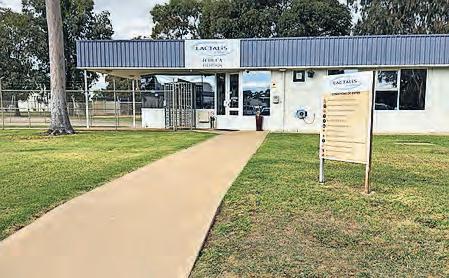



Since the introduction of robotic milking on his family’s two farms at Mt Compass in South Australia, Jake Connor has embraced the shi to voluntary milking . PAGE 8
GEA DAIRYROTOR T8500
Proudly proven on pasture-based farming operations, the T8500 is a reliable, robust rotary milking system that can be operated with just one milker.
Whether you’re looking to increase cow throughput, reduce labour or gain individual cow data, the T8500 is a hardworking and reliable rotary that won’t let you down - now and in the future.
Contact your local dealer today for an on-farm consultation.

Australian Breeding Values. Pages 24-28 MAY, 2024 ISSUE 163 // www.dairynewsaustralia.com.au THOUSANDS FLOCK TO FARM WORLD PAGES 20-23
COWS IN CHARGE CHARGE
LACTALIS TO CLOSE FACTORY PAGE 5
Scan for more details. GEA.com/dairyfarming | 03 8877 9999




















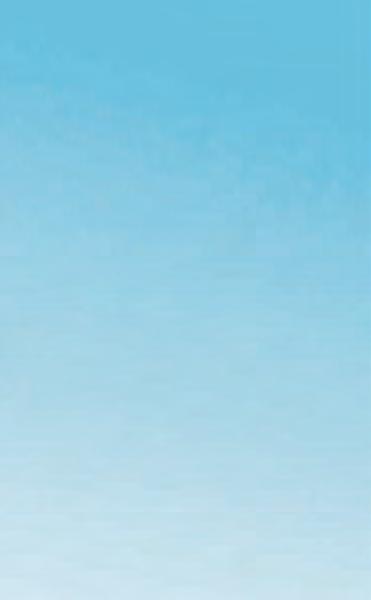








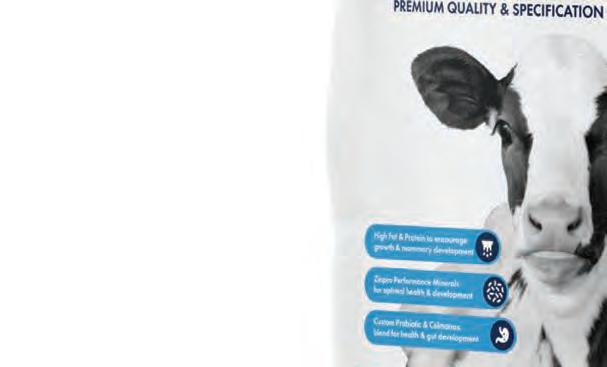









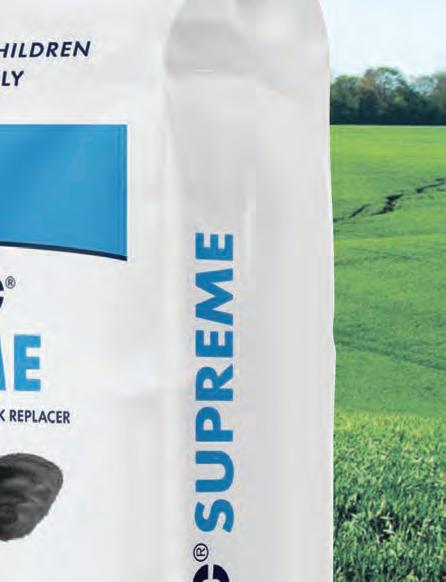
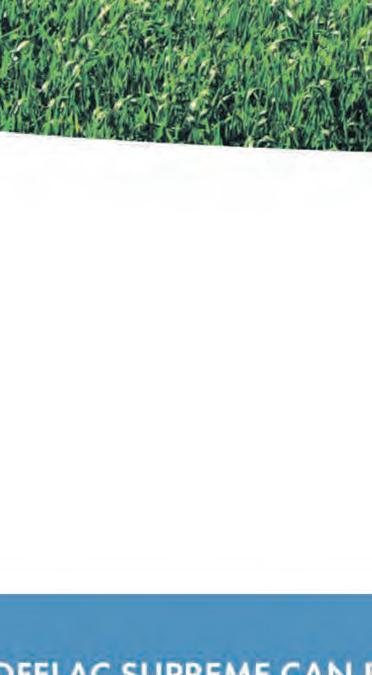
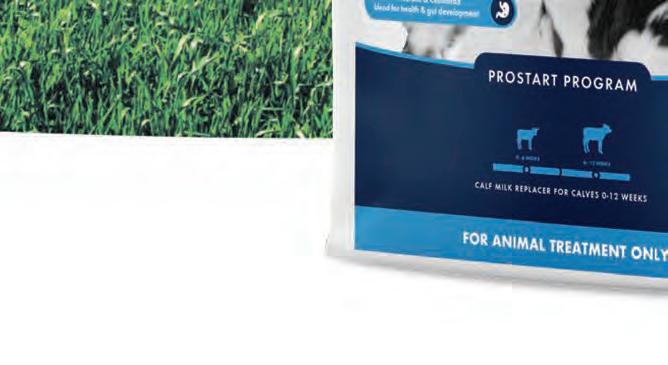




















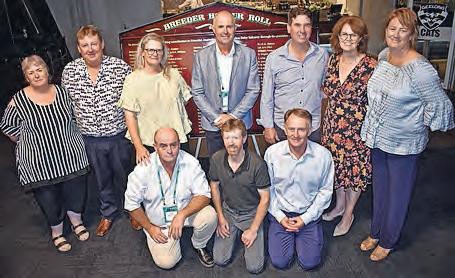


Commodity prices are nding their feet
BY ELIZA REDFERN
WEAK GLOBAL demand has guided the fall of dairy export prices over the past two years, and after some recovery leading into 2024, the market is now finding its balance.
While today’s fragile economy keeps demand at bay, dairy commodity price movement remains mostly driven by global supply.
Inflationary pressures continue to impact dairy consumption and tighten importer margins. As such, importers are purchasing as needed, maintaining relatively full warehouses.
Dairy export commodity price increases over the opening months of this year have started to deter buyers, and as milk flows in the Northern Hemisphere reach peak seasonal production, many importers are holding back orders in hopes of prices easing.
Such behaviour contributed to the value of some dairy products dropping during March GlobalDairyTrade (GDT) events, despite volumes on offer tracking lower than last year.
At the same time, purchasing activity from the world’s largest dairy importer remains limited. The Chinese economy slipped into deflation in July last year, further undermining business and consumer confidence.
Ongoing consequences of strict COVID-19 control measures, increased regulation on private enterprises, a prolonged real estate crisis and uncertainty around youth employment have created economic headwinds.
While this economic slowdown amplifies generally sluggish consumer demand, robust local milk production and product stockpiles continue to limit importing activity from Chinese buyers.
While such headwinds to global demand weigh on dairy export prices, global supply has been the main source of movement.
Fluctuating pasture growth conditions led to milk production dropping (on a tonnage basis) over the first half of the New Zealand season, with some increases in December and February.
In the United States, milk production has been tracking below last year (aside from a leap year driven increase in February), however a significant focus on cheese production has helped maintain its price competitiveness.
Across Europe, milk volumes have tracked below last year since September 2023. However, signs of increasing milk production across the region in March have started weakened dairy commodity values from the region.
Similarly in Australia, rising milk flows (beyond initial expectations) have increased the availability of some products for export and are weighing on prices as a result.
In addition to the push and pull of the dairy fundamentals, cheaper international dairy products are competing against Australian dairy on both home and global grounds.
As it stands, the global market provides more opportunity for many Australian manufacturers, however, competitive pressure is strong.
The cheese category has been a production focus, especially over the past two years, as demand from Japanese buyers helps support the value of products such as cream cheese.
Lower returns for milk powders
Source: Dairy Australia
(especially whole milk powder), driven by limited importing by Chinese buyers, has deterred their production and disincentivised the skim milk powder/butter stream.
As such, the value of Australian WMP and butter have closely followed the GDT trajectory, as the former is only produced in limited cases, and the latter has found significant price support (despite the boost in Australian availability).
Global dairy trade will continue enduring a persistently challenging economic environment.
With a low likelihood of demand headwinds easing anytime soon, dairy export prices will adjust mostly according to changes in supply.
A lack of substantial production growth (especially during the Northern Hemisphere spring) will help retain some support for export commodity prices, but ultimately limited import demand will prevent significant recovery.
Eliza Redfern is the Dairy Australia analysis and insights manager.

















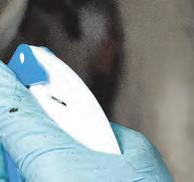


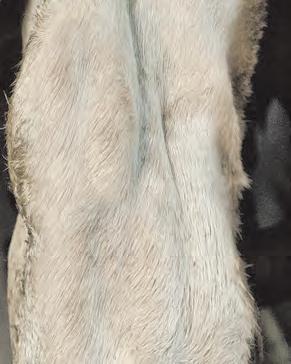







NEWS
FARM WORLD
AUSTRALIAN BREEDING VALUES
ANIMAL HEALTH 29 MACHINERY & PRODUCTS
3–19
20–23
24–28
30–31
GA honours elite breeders. PG.6
Robots future-proof farming. PG.10
Dayboro’s last dairy farm saved. PG.15
// 3 DAIRY NEWS AUSTRALIA MAY 2024 NEWS UPGRADE YOUR UDDER HEALTH? IS I T T I M E TO delaval.com Talk to the Upgrade Specialists 1800 817 199
matter what
milk with, DeLaval has a solution to help improve the udder health of your herd. Whether you prefer to dip or spray, clean or disinfect, condition or defend, we’ve got you covered.
No
you
FARMERS APPLAUD GROCERY CODE REPORT
EastAUSmilk has praised the interim review of Australia’s Food and Grocery Code.
Joe Bradley, chair of the eastAUSmilk board, said the review adopted the two key proposals from eastAUSmilk — that the code must be mandatory, and that it must address the issue of supermarket retaliation against suppliers.
“Without these two changes, the Food and Grocery Code would have remained ineffective and ignored,” he said.
“It is great to see Craig Emerson has moved so quickly to make substantive findings and recommendations.
“Now we call on the government to move with great speed to implement his recommendations.
“There is no need to wait for his final report, before getting to work on implementing his most important recommendations.”
The interim report was released on Monday, April 8 and Dr Emerson’s final recommendations will be handed down by the end of June.
Mr Bradley said while the Food and Grocery Code impacted dairy farmers mostly indirectly, it is very much in the interests of dairy farmers across Australia that the relationship between supermarkets and their suppliers is cleaned up.
“It is also very much in the interests of the whole Australian community that the big supermarkets, who have such a powerful influence on everyone’s cost of living, are properly scrutinised and regulated.
“EastAUSmilk sees this interim report as a very solid and timely step towards that scrutiny and regulation — but only one step. Big supermarket margins now have to be examined closely.”
Supermarkets could face massive fines of up to $10 million for misbehaving under the recommendations made in the review of the Food and Grocery Code.
But the review does not back the forced break-up of supermarkets as a method of addressing market concentration, warning of less competition and job losses for workers.
Dr Emerson, a former competition minister who led the government's review, "firmly" recommends the “not effective” code be made mandatory and apply to supermarkets with yearly revenues exceeding $5 billion.
This would capture Coles, Woolworths and ALDI.
Under the changes, the Australian Competition and Consumer Commission would be brought into code enforcement and would be able to push for fines worth
up to $10 million, 10 per cent of a supermarket’s annual turnover, or three times the benefit it gained from the breach.
“A heavy imbalance in market power between suppliers and supermarkets in Australia’s heavily concentrated supermarket industry necessitates an enforceable code of conduct,” Dr Emerson said.
“The code should also be strengthened to better protect suppliers, as their fear of retribution would compromise its effectiveness.”
The report says greater competition in the supermarket industry can be helped by an effective and mandatory code of conduct, enforcement of competition laws by the ACCC and policy reforms to planning and zoning.
It warns if forced divestiture resulted in a supermarket selling some of its stores to another large chain, the result could be even greater market concentration.
Bird u found in US milk
ONE IN five commercial milk samples tested in a United States-wide survey contained particles of the H5N1 virus, the US Food and Drug Administration says, suggesting the current outbreak of bird flu is more widespread than previously thought.
The agency said there is no reason to believe the virus found in milk poses a risk to human health.
“This says this virus has largely saturated dairy cattle throughout the country,” said Dr Michael Osterholm, an infectious disease expert at the University of Minnesota.
Many infectious disease experts and government officials have said they believe the pasteurisation process will inactivate the virus, also known as avian influenza.
However, additional testing is needed to confirm that there is no infectious virus in the milk, the agency said.
“To date, the retail milk studies have shown no results that would change our assessment that the commercial milk supply is safe,” the FDA said on April 26.
“I’m not worried about the milk itself. It does indicate that the virus is more widespread among dairies than we had previously thought,” said Samuel Alcaine, associate professor, of food science at Cornell University.
“We had a little over 30 herds or farms that had been reported as having positive for avian
influenza. We have just under 30,000 farms across the US. Thirty-three is a really small number. It makes it seem like there is definitely more spread out there.”
Eight US states have confirmed cases of bird flu in 33 dairy herds, according to the US Department of Agriculture — Texas, Kansas, New Mexico, Ohio, Idaho, Michigan, North Carolina and South Dakota.
Dairy cattle moving between states must be tested for the bird flu virus, agriculture officials said, as they try to track and control the growing outbreak.
Only one person — a Texas farm worker — has been confirmed to have bird flu in the current outbreak.
The patient suffered conjunctivitis, an eye irritation that can cause redness and discomfort.
The FDA said the US Centers for Disease Control and Prevention has not recorded additional human cases beyond the first confirmed case.
FDA is further assessing any positive findings through egg inoculation tests, which it described as a gold standard for determining viable virus.
The World Health Organisation said on April 26 that the current overall public health risk posed by H5N1 bird flu virus is low but for those with exposure to infected birds or
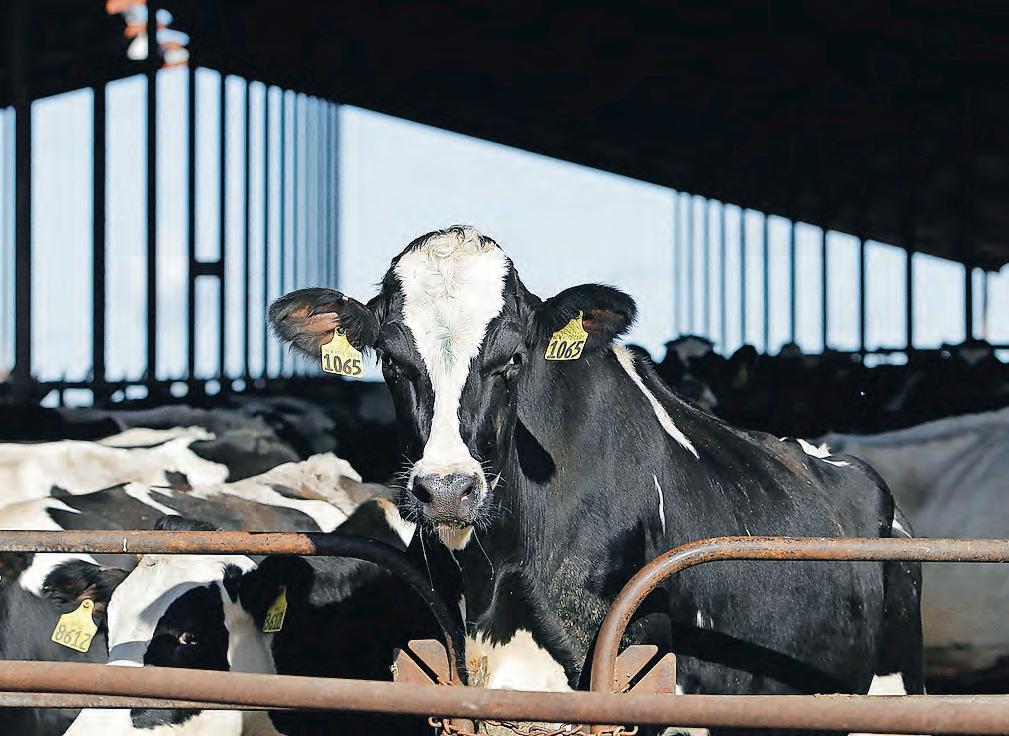
moderate.
“The
been




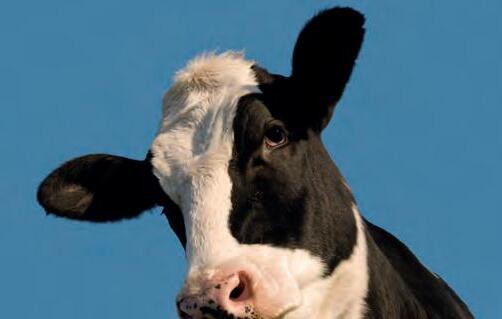
 animals the risk of infection is considered low to
animals the risk of infection is considered low to
– From
virus has
detected in milk and its potential role in transmission is being investigated,” the agency added.
Reuters.
4 // DAIRY NEWS AUSTRALIA MAY 2024 NEWS Request a quote 1800 724 214 | www.achmea.com.au Insurance issued by Achmea Schadeverzekeringen N.V. (Achmea) ABN 86 158 237 702 AFSL 433984. The information in this document is general advice only and does not take into account your individual objectives, financial situation or needs (your personal circumstances). This means any advice may not be appropriate for your circumstances. Before using this information to decide whether to purchase the insurance policy, you will need to consider the appropriateness of any general information or advice we give you and how it relates to your specific situation to ensure the insurance cover meets your needs and the relevant Product Disclosure Statement and Target Market Determination (TMD) available from the ‘Downloads’ section of our website achmea.com.au/downloads. For feedback and complaints, visit achmea.com.au/complaints. To view Achmea Australia’s privacy statement, visit achmea.com.au/privacy. BEEN A WHILE SINCE YOU REVIEWED YOUR FARM INSURANCE? Contact us today to request a tailored farm insurance quote. George MacDonald, Wallabadah NSW “ Helpful. Efficient. Timely.”
Cows at a dairy farm in the US. The US Food and Drug Administration says samples of pasteurised milk have tested positive for remnants of the bird flu virus that has infected dairy cows. (AP Photo/Rich Pedroncelli)
Lactalis to close factory
THE ECHUCA Lactalis dairy factory is expected to close soon, after the company announced it was moving its yoghurt and dessert processing to its Bendigo site.
The shift is not expected to disrupt milk supply from district farmers.
Lactalis is one of Australia’s largest dairy processors and purchases milk from hundreds of dairy farmers across all Australian states.
The company produces a range of dairy products across a number of brands including Pauls, Oak, Vaalia and Ice Break.
The news of potentially 74 jobs lost in Echuca was dropped when the company announced a three-year, $85 million investment to make Bendigo its primary location.
“Our long-term plan to meet future growth aspirations was made after a detailed review of our Yoghurt and Desserts Division,” Lactalis chief executive Mal Carseldine said.
“The plan sees us have one regional hub in Victoria that is fully utilised. Our selection of which site considered: milk processing capability, operating costs and site layouts.
“Based on this criteria, our Bendigo site was the most suitable option for us to invest in to meet our future needs in Victoria.
“We are now consulting with our Echuca team about these decisions, including how to best support them through the implementation.”

Mr Carseldine said there will be some opportunities for redeployment of Echuca staff.
The additions to the Bendigo facility will see more jobs, a new production line, and more yoghurt and custard capacity.
Australian Manufacturing Workers’ Union organiser Chris Spindler said he had been given
very little information about the move from the company.
“We have very little information about what they’re proposing other than a throwaway comment about investment in Bendigo, but even that doesn’t mean much at the moment,” he said.
AUSTRALIA TO HOST NEXT JERSEY CONFERENCE
Australian Jersey cows will be showcased to a global audience with the World Jersey Conference coming in 2025.
The World Jersey Cattle Bureau has agreed to host its annual conference in Australia for the first time since 2011.
The conference will start April 6 and finish at the Royal Sydney Show Jersey judging on April 21.
A preliminary itinerary has been developed and will take visitors through Victoria and the NSW south coast, starting at the Gippsland Jersey Autumn Fair and visiting western Victoria before moving to northern Victoria where the Dairy’s Finest sale will be part of the program.
The delegation will then continue to Bega and along the south coast to Sydney.
Up to 100 people from across the globe — including Europe, North America, New Zealand and Asia — are expected to join Jersey farmers on the tour.
The conference was last held here in 2011 when Australia stepped in after the tsunami hit original host Japan.
It had been planned to return to Australia in 2021 but was deferred because of COVID-19.
This year the conference is in Denmark and it was held in Guatemala in 2023 and virtually from Rwanda in 2022.
One of the highlights of the Australian program will be a Future Leaders Forum with Jersey organisations around the world being invited to sponsor a potential future leader to attend.
Jersey Australia general manager Glen Barrett said hosting the conference would build on the international marketing done in recent years to promote Australian Jerseys.
“Part of our reason for applying to host this event is to capitalise on the global

marketing we have been doing in recent years,” Mr Barrett said.
“We see this as a celebration of Australian Jerseys, with a strong focus on Australian cow families and sires.
“The visitors will see some great Jerseys along the journey.”
Jersey Australia has led a joint trade site at World Dairy Expo at Madison in Wisconsin, in the United States, for the past two years which has led to improved international product recognition and sales.
“There is growing interest in the export market,” Mr Barrett said.
“We had our first shipment of heifers to Indonesia last year, more heifers are about to be shipped to Pakistan, the Chinese market is growing again and there is a shipment being prepared to go to the UAE.
“There is certainly a growing market for
“We don’t know whether that results in jobs or how it impacts the people who will lose their employment.”
The union said it expected Mr Carseldine to visit the Echuca site next week and that it hoped plans for the future would become clearer.
Last year Lactalis was fined almost $1 million by the Federal Court for breaching the Dairy Code of Conduct.
Lactalis, formerly known as Parmalat, is a French-based multinational company.
Following proceedings brought by the ACCC, the court found that Lactalis had breached the code by publishing and entering into agreements with milk suppliers that allowed Lactalis to unilaterally terminate an agreement in circumstances that didn’t involve a material breach by farmers.
In particular, under the agreement, Lactalis was permitted to unilaterally terminate the agreement when, in Lactalis’ opinion, the farmer had engaged in “public denigration” of processors, key customers or other stakeholders.
The court also found that Lactalis had breached the code by failing to publish its milk supply agreements on its website, and instead required farmers to sign up to receive their milk supply agreements by email.
Australian Jersey heifers and Australian genetics.”
Domestically, Jersey numbers have been increasing year-on-year and Jerseys now account for more than 15 per cent of the national herd, up from 10.5 per cent 15 years ago.
Mr Barrett predicted that interest in Jerseys would spike after the conference.
“Bringing international Jersey breeders here to see first-hand the high-quality cattle we’re breeding from high-quality Australian bulls will definitely benefit our local industry,” he said.
“The conference rotates around the world and we think we have the best Jersey cows in the world so we wanted to showcase them.
“This will be a great opportunity for Australian businesses to support the event and promote their Jersey genetics and products to the world.”





 Lactalis will move its yoghurt and dessert processing from its Echuca factory (pictured) to an upgraded Bendigo site.
Lactalis will move its yoghurt and dessert processing from its Echuca factory (pictured) to an upgraded Bendigo site.
// 5 DAIRY NEWS AUSTRALIA MAY 2024 NEWS BEST-START ™ THRIVE Bovatec® - research proven to control clinical signs of coccidiosis Celmanax™ - research proven to reduce the incidence, severity andduration of scours(including cryptosporidiosis) Safmannan® – research proven to improve immune response and bind a broad spectrum of major pathogens (E. coli and Salmonella) Betaine – osmoregulator to aid hydrationandgutwallintegrity Soluble Vitamins and Organic Trace Minerals suppliedinquantities to meet or exceed the calf’s daily requirements Prebiotics&Probiotics to aid digestionandgutmicrobialbalance (15 billion CFU per 10 gram dose) Next generation calf supplement based on innovative research and development; contains: For more information, or to locate your local stockist, call Jon Reynolds. 4Sight Global | www.4sight.bio | jon@4sight.bio | 0423 008 495 BOVATEC BUILT WITH FORMULATED ON We changed to BEST-START THRIVE this season - it’s been an absolute game-changer for calf health and condition!
Photo: Aidan Briggs.
GA honours elite breeders
ELEVEN AUSTRALIAN farmers
whose bulls have made a huge contribution on the national herd and many herds across the globe have been added to the Genetics Australia Honour Board.
Six Jersey, three Holstein and two Australian Reds breeders received the honour during the GA 2024: Today, Tomorrow and Beyond conference in Geelong on March 18, joining an elite group of master breeders.
Genetics Australia chief executive officer Anthony Shelly said the honour board, which takes pride of place in the GA boardroom, features Australian as well as several overseas breeders who have bred bulls that made a significant mark on genetic improvement in Australia.
“Our latest breeders added to the list thoroughly deserve this accolade,” Mr Shelly said.
“While they all have different approaches to their breeding, all have made a massive contribution to the growth and genetic improvement of their respective breeds in Australia.”
Traditionally, selection to the honour board was based primarily on proven bulls but today it is a broader combination of genomic and proven bull successes.
Johville Australia Reds owned by Greg and Kris Goulding, at Leitchville in northern Victoria, has supplied a number of bulls to the GA team, including the current number one BPI bull SKEETA.
SKEETA has been popular in Australia and has significant export sales into Europe and Pakistan. Other bulls of significance include SCAREBEAR, BOOBOO, TEDEBEAR and YOGIBEAR.
Waikato Australian Reds is owned by Michael Green, formerly of Mt Schank in South Australia but now farming in Irishtown, Tasmania.
The herd transitioned to have a heavy influence of Australian Red cows following the purchase of the Bosgowan Australian herd, and is the current number 2 BPI Australia Red herd.
Bulls such as ARBPRIMESTAD and ARBCAESAR have been bred by Waikato Australian Reds as well as several formerly available through AUZRED XB, now sold by Genetics Australia.
Calister Holsteins, owned by Craig Lister, from Calivil in northern Victoria, has made a mark with

two bulls, one from an embryo and another he bred.
MAEBULL at 99 per cent reliable has proven to be a popular bull and is still in active service with farmers appreciating his reliable health traits. Over the next few months there will be thousands of MAEBULLs calve in Pakistan.
Popular sire DECIPHER was also bred by Calister and offers a good balance of dairy strength and high BPI.
Wilara Holsteins, owned by chair of Genetics Australia Holdings
Trevor Henry at Tinamba in Gippsland, has a well-recognised prefix and bulls that have been highly valued around the country, including proven successes such as GILES.
Newer bulls including LUKIE, TINAMBA, TWITTER are all above 500 BPI and are making an impact on the market with high demand.
Vala Holsteins, owned by Alex Arena and based at Toolamba in northern Victoria, initially started as COOBOONA Holsteins and in its peak was implanting some 1500 embryos.
One of the most significant bulls
to come from the program was homozygous polled Red Carrier bull MIRAND, which was heavily exported around the world.
Joining MIRAND are EMMETT, ESCHER, LEMONADE, BEACON, DOUGLAS, EPIC, LENN and MRRIGHT and several others.
Mr Arena aims to be ahead of the pack by placing emphasis on polled, A2 and in recent times slick.
Wallacedale Jerseys, owned by Luke and Mel Wallace from Poowong North in Gippsland, has some very popular bulls in the current GA line up including homozygous bull STARK, as well as GOLDBANDP, PICKETT, DEPOLE, LEMONPEEL, and former number one bull PICKLE.
A number of the herd’s high-rated genomic heifers have also been sold to Pakistan where they are showing the quality of Australian Jerseys, paving the way for increased semen sales.
Rob and Kerrie Anderson’s Kings Ville Jerseys, at Drouin West in Gippsland, has developed some of the breed’s finest cow families.
Kings Ville BEDFORD continues
to sell in large numbers in South Africa and other Kings Ville bulls include BOOST, QANTAS and in the past year BASHFUL, sire of BEDFORD, obtained his first ABV.
A few new Kings Ville bulls are likely to be added to the 2024 sire line-up.
Con and Michelle Glennen, from Noorat in western Victoria, have waved the Australian Jersey flag in several countries including the United States, South Africa, New Zealand and Ireland.
Their White Star Jersey herd is the current number 1 BPI, HWI and SI herd.
The Glennen herd was one of the early adopters of AI and the herd has used AI ever since bulls became available. Standout bulls include DOUGGAN, DOBSON, VALENBLAST and recently ENMORE.
Robert and Sandra Bacon developed Brookbora Jerseys at Tennyson in northen Victoria, currently the number two BPI herd.
Brookbora ASKN has been a very popular bull internationally and has daughters in the US, Canada, South
Africa, Pakistan Europe, the United Kingdom and Jersey Island.
BORUNG is currently the highest bull with milking daughters, from an ASKN daughter and the third Brookbora bull is AEROGLEN, sired by BORUNG.
After Robert’s death last year, the herd is being continued by Sandra and their son Daniel.
Bercar Jerseys, owned by Bernie and Carol McManus from Bamawm Extension in northern Victoria, bred a bull called PASSIVE in the mid-2000s and today ARDENT, the number two Jersey bull with milking daughters, and BESTYET are also successful Bercar bulls.
Bernie and Carol have now retired from dairying but Bercar will continue to have an impact through these bulls for many years to come.
Loxleigh Jerseys, owned by Geoff and Natalie Akers from Tallygaroopna in northern Victoria, is another Jersey herd that ranks with the best in the world.
INVINCIBLE, IZUKU, IRYMPLE and VENTURA are all bulls having an impact now and will continue into the future.
Dairy News Australia is published by Shepparton Newspapers Pty Ltd. All editorial copy and photographs are subject to copyright and may not be reproduced without prior written permission of the publisher. Opinions or comments expressed within this publication are not necessarily those of the staff, management or directors of Shepparton Newspapers Pty Ltd. WWW.DAIRYNEWSAUSTRALIA.COM.AU Advertising Max Hyde 0408 558 938 max.hyde@dairynewsaustralia.com.au Editor Sandy Lloyd (03) 5820 3252 editor@dairynewsaustralia.com.au Regional editor news@dairynewsaustralia.com.au Publisher Shepparton Newspapers Pty Ltd Printed by Newsprinters Pty Ltd Head Office 7940 Goulburn Valley Highway Shepparton, VIC 3630 Phone (03) 5831 2312 Postal address PO Box 204 Shepparton, Victoria 3632 Australia Dairy News Australia welcomes contributions from stakeholders in the dairy industry, and particularly from organisations wishing to advance the industry.
and photos can be sent to: editor@dairynewsaustralia.com.au
to
editor on topical issues are also welcome.
should be concise and carry the name and town address of the author, as well as a contact phone number, not for publication.
Contributions
Letters
the
Letters
6 // DAIRY NEWS AUSTRALIA MAY 2024 NEWS
At the Genetics Australia honour board presentation were (from left) Kris and Greg Goulding, Michelle and Con (kneeling) Glennen, Trevor Henry, Luke Wallace (kneeling), Rob and Kerrie Anderson, Geoff Akers (kneeling) and Sandra Bacon.








































WILL YOU FARM WITH ME?











CowManager: a Strong Partnership



Monitoring cows isn’t just business; it’s a partnership built on trust. From sunrise to sunset, in sickness and in health, we’re here to support you and your herd every step of the way.
Consider CowManager your farming partner. Scan the QR code to see all the benefits.
Let’s Do Better Together
Our ear sensors monitor your dairy cows 24/7, in real-time. We help you increase preg rates, monitor herd health, and tackle the transition period. Gain full control of your herd management and make your workload more efficient.



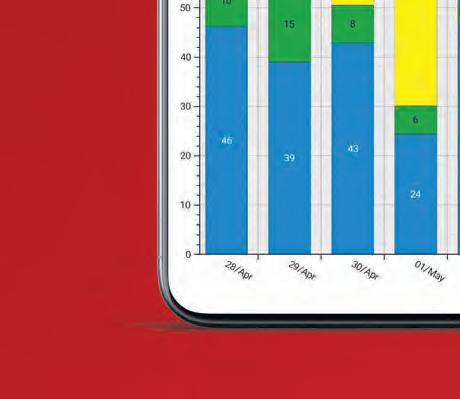


YES, I DO!
AHEAD OF THE HERD TOGETHER Paul Quinlan 0447 047 425 pquinlan@wwsaustralia.com
Cows milking it for choice
BY RICK BAYNE
JAKE CONNOR doesn’t mind playing second fiddle to his cows; in fact, he’s happy to sit back and let his cows decide when they want to milk.
Since the introduction of robotic milking on his family’s two farms at Mt Compass in South Australia, Jake has embraced the shift to voluntary milking.
“The data is great, but the most important thing a robot enables is cows milking voluntarily,” Jake said.
“The robot does a perfect milking every time, you get a lot of data, and you don’t have to be there milking your cows, but the big change in the farming system is going from traditional batch milking to a cow making her own decisions about when she wants to milk.
“It is a different way of farming. My passion in robots really comes from voluntary milking, which often gets overlooked when people talk about robots.”
Jake shared his experience as part of a robotic milking panel at the GA 2024: Today, Tomorrow and Beyond conference in Geelong in March.
The fourth-generation dairy farmer works alongside his parents Jodie and Michael, brother Brad, sister Chelsea and Reece Donhardt, and two full-time employees.
Prior to the introduction of robots, the farm had two more full-time staff and four casuals for milking.
One of the farms has eight robots with 450 cows, the other six robots and 350 cows.
Both herds are 80 per cent Holstein and 20 per cent Jersey after they expanded about eight years ago by purchasing a neighbour’s Jersey herd.
Jake, who now also works part-time for Lely in addition to his farm duties, started investigating robots in the middle of COVID-19.
While one farm had a good 60-unit rotary dairy, the second had a 12-aside double-up milking 350 cows that needed replacing.
“We couldn’t travel and do a lot of research. I’d only ever seen one Lely farm but I believed in the system and the bank jumped on the idea,” Jake said.
They had also secured long-term milk price contract offered by La Casa Del Formaggio, providing some confidence and security.
They started with six robots three years ago. Within six months they had decided to introduce robots across the whole business and the second robotic dairy was installed in October 2023.
Jake didn’t worry about the payback period,
instead concentrating on whether they could cashflow the investment and if it would create a sustainable future for the business.
There have been many positives to come from the transition, starting at work-life balance, but also in production and fertility.
“The dairy is the most important investment on your farm, but sometimes it can be down at the bottom of the list you spend money on,” Jake said.
“Saying you can’t afford to upgrade the dairy never sat well with us. Any spare money we invested back in the dairy.”
They spent $2 million on a greenfield site for the first robotic installation.
The COVID-19 threat to staff numbers was one of the initial driving factors.
“At the time of COVID, we were worried about how that would affect us, particularly relying on staff to milk cows,”Jake said.
“You still need staff, but there’s less reliance on them and it’s a better job for those working there so it attracts higher quality people.”
In fact, one key staff member, former herd manager Tom Vitkunas, returned to the business after the introduction of robots.
“Tom had been with us for 10 years but left because he was sick of milking cows. Him coming back was a blessing for us,” Jake said.
“He’s embraced this system and it has changed how he looks at the dairy industry. It’s like a different job for him.”
Jake admits the start-up period for training cows is tough.
“It’s a lot for the cows and the farmer to learn,” he said.
“You’re asking the farmer to forget all their years of dairy farming and start from scratch, but it’s only seven days till your cows learn that this is their new dairy.
“From then on, it’s a transition to cows learning they are now in charge of the system and that they milk when they want to be milked, not waiting for the farmer to tell them when they have to be milked.
“That transition happens over two to three months, but it’s not as stressful because you’re not pushing them on to the robots – it’s about letting them decide what they want to do.”
Herd management fully relies on the software.
“I have full trust in the data,” Jake said.
“From a herd management perspective, it puts you well ahead.”
The robots have led to a 15 per cent increase in production and a similar rise in the six-week in-calf rate.
“We like to sit at 2.5 milkings per day,” Jake said.

“We know more than two milkings a day drives production which drives intake.
“Combining the milkings with three-way grazing means we’re able to get about 3kg more dry matter forage into our cows to drive production.”
The farms had fertility struggles for 20 years, despite trying many different correction measures for very little improvement.
“For whatever reason, robots have improved our six-week in-calf rate by 15 per cent which has been significant to our business,” Jake said.
“I think it’s more to do with voluntary milking. The cows eat and milk when they want to.”
He points out farmers won’t save on power bills in a robotic dairy, but the higher overall shed costs are offset by a reduction in labour costs and production benefits.
“We’ve had a significant reduction in labour, though what happens outside the shed still needs to happen, and it’s paying for itself in production and fertility.
“They’re paying for themselves twice as quick as we thought they were going to.”
The work day is now set from 7am to 4pm.
Jake said cow traffic flowed well through the robots.
“Australia has a big opportunity for more robotic dairies,” he said.
“Compared to the rest of the world, we’ve got a low percentage of cows milked by robots.
“I see them playing a massive role in our industry. They will prolong dairy careers, including smaller farms, and be an important part of our dairy industry moving forward.”


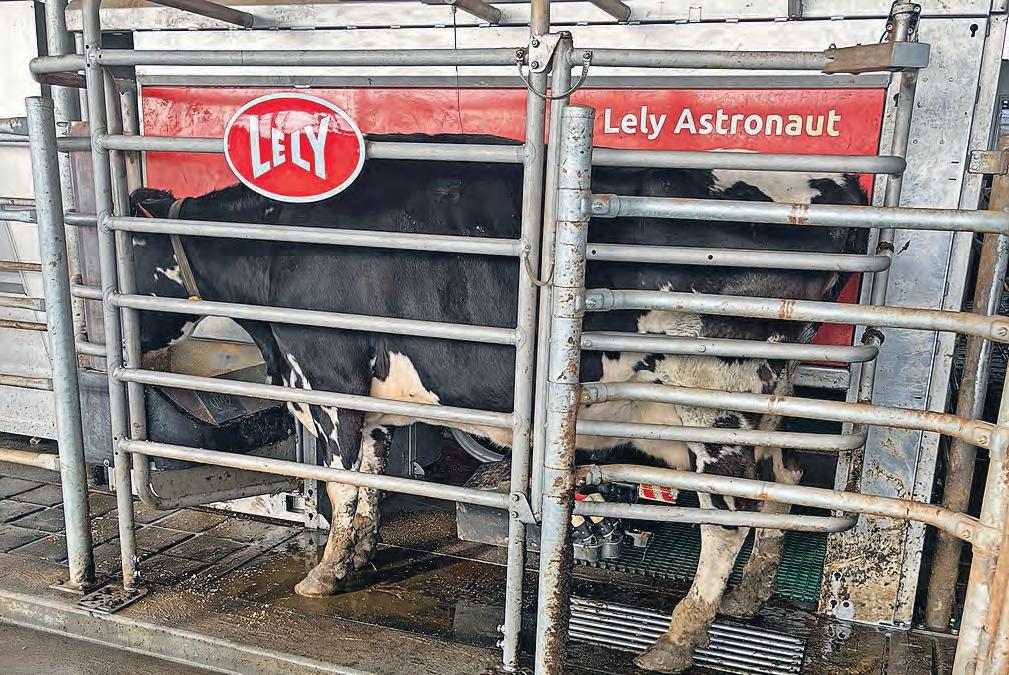


 Jake Connor addresses the GA 2024: Today, Tomorrow and Beyond conference.
Jake, Chelsea (holding her daughter Jade), Jodie (holding granddaughter Zoey) and Michael.
The cows are happier, healthier and producing more since the introduction of robotics.
Jake Connor addresses the GA 2024: Today, Tomorrow and Beyond conference.
Jake, Chelsea (holding her daughter Jade), Jodie (holding granddaughter Zoey) and Michael.
The cows are happier, healthier and producing more since the introduction of robotics.
8 // DAIRY NEWS AUSTRALIA MAY 2024 NEWS WORK SMART WORK SAFE ...YOU NEED A WRANGLER THE WRANGLER R 101635 THE WRANGLER IS ESSENTIAL EQUIPMENT FOR EVERY FARM Save yourself time, The Wrangler makes hooves a quick, easy one person job. It’s like an extra pair of hands so your staff can get on with other jobs. Phone Laurens: 0475 757 720 Email: australia@thewrangler.net
Jake Connor joined Symone Vines and Luke Wallace to discuss robotic dairies at the GA conference.




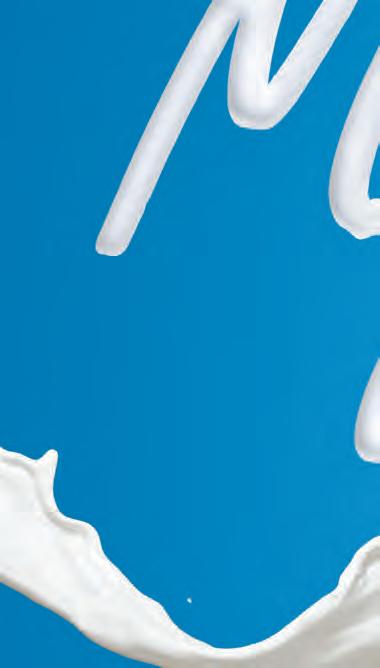
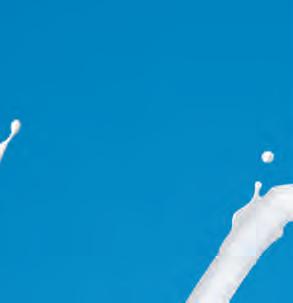





























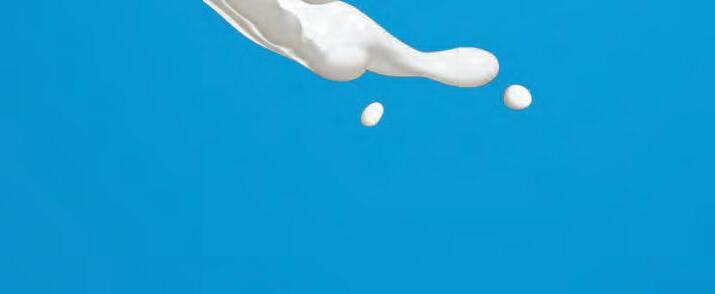







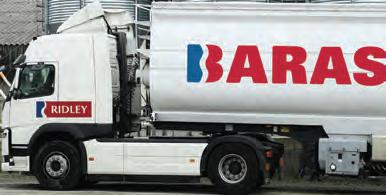

Barastoc cares about your dairy cows as much as you do. Each element of our operation is designed to support the best possible animal nutrition and health, and maximise your production. Through all life’s stages and seasons. That’s why Barastoc is truly Made For Milk. For more information on our range please contact your local Ridley Team of Dairy specialists on 1300 531 833 or email us on info@ridley.com.au.
DAIRY FEED All rights reserved, © 2023. Barastoc is a registered trademark of Ridley Agriproducts Pty Ltd. CALL US ON 1300 531 833 FOR BULK FEED DIRECT TO FARM BROUGHT TO YOU BY
BULK
Robots future-proof farming

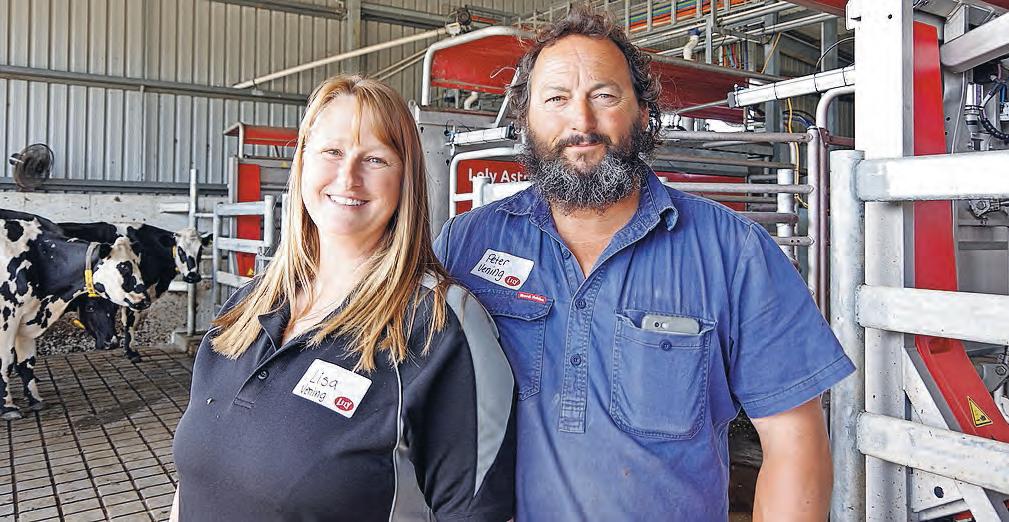
 BY JEANETTE SEVERS
BY JEANETTE SEVERS
IT IS nearly 12 months since a greenfield site on an existing family farm began operation as a robot dairy milking system.
The Vening family at Hedley, Victoria — Peter, Lisa, and their sons, Shawn, Jarrod and Trent — are milking their cows in eight new Lely Astronaut A4 robots, in a purpose-built shed.
The original Vening family began farming in 1923 at Hedley, in South Gippsland. They milked Jersey cows.
Fast forward, Peter and Lisa Vening took over the family dairy farm in 1999 and installed a 30-aside swingover herringbone dairy.
“In about 1990, Peter took over AI responsibilities on his parents farm,” Lisa said.
“He used a lot of Friesian semen, and we built it up so the majority of the herd was crossbred by 1999, when we bought the farm off Peter’s mum.
“By then we were milking 280 to 300 cows; and we also built a 30-aside swingover dairy in 2000.”
The next major modification was to install a bale feeding system with headstalls in 2007.
“We then added cup removers,” Lisa said.
On a holiday in England in 2013, the couple viewed a Lely milking robot at a dairy fair and their plans for installing robots on their own farm began that day.
By this stage they were milking 360 to 390 cows.
They also admired the computer programs used by European and UK dairy farmers, and came back to Australia, keen to find something suitable for their farm.
“It was hard to find in Australia, built for our farming conditions,” Lisa said.
“Later that year, we saw what we wanted at Korumburra, at the South Gippsland Dairy Expo.
“It was the Jantec herd management software and it was able to take all the cow information — all the herd testing results, the calving dates for each cow, and time for drying off.
“It was so good to have all that data in there. Now we take those type of computer programs for granted.”
The Jantec computer system was installed in 2014 in the dairy, along with automatic drafting gates.
The software enabled Peter and Lisa to use data about herd health to inform their decision making, keep accurate records about breeding and genetics, and draft cows that needed veterinary care, as well as separate treated milk
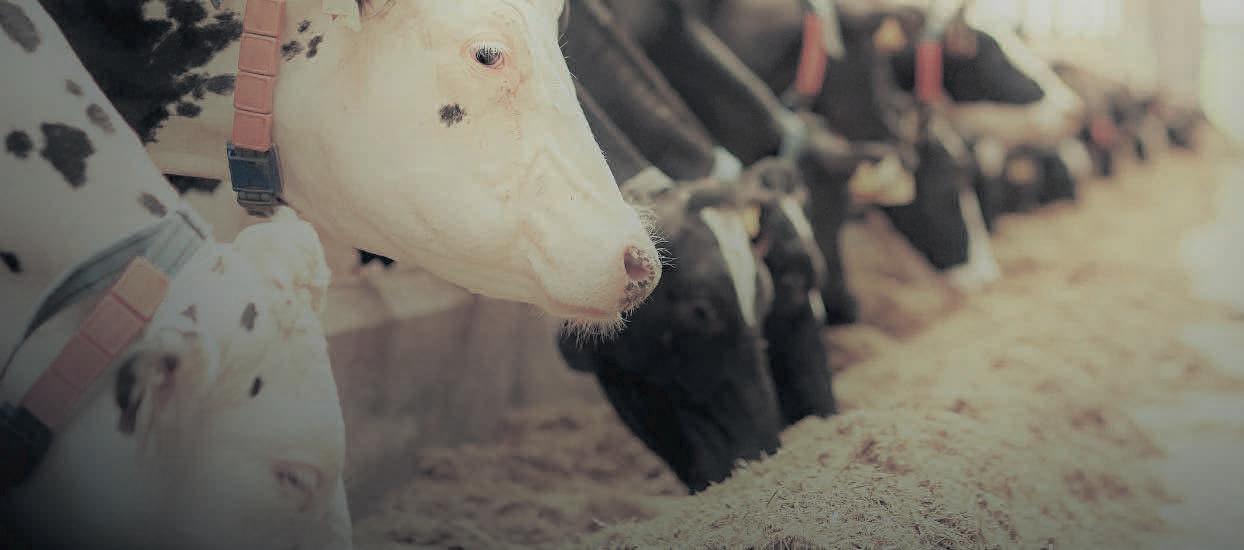
in the dairy.
In 2017, with their three sons interested in working on the dairy farm, the family began talking about the future of the business and succession planning.
“Shawn finished Year 12 and he decided during that year he wanted to be part of the farm,” Lisa said.
“When Jarrod finished school, he went into an apprenticeship, then worked in Western Australia. Two years ago, he came home from WA.
“Trent was at school and he decided during the pandemic to commit full-time to farming.
“We’ve all worked together over the past two years and it’s been good.”
During that time, Peter and Lisa invested in more land to build the self-sufficiency of their business.
“We bought a second farm about four years ago — the farm up the road, with pivot irrigation, so we could be self-sufficient,” Lisa said. They grow all their own fodder and only buy in the herd’s grain portion.
“We also have a block for dry cows and heifers that’s separate to the milking area,” Lisa said.
Having their three sons involved full-time in the farm coincided with Lisa and Peter deciding to go ahead with installing a Lely robot dairy; a decision that was always going to happen.
But the timing of it was also affected by local infrastructure work — a public access recreational rail trail would go straight through their property, directly behind the herringbone dairy shed and yards.
“When we knew they were going to build it, we had a lot of issues because the dairy yard opened right onto the rail trail, so there was no way of holding the cows back from crossing it to get to their paddock,” Lisa said.
“We knew we had to do something that was safer.
“The old dairy shed was in close proximity to daily passers-by.
“We didn’t want people walking right past where we’re working with animals.”
Rather than retrofit into an old shed, Peter and Lisa decided to establish their dairy platform on a greenfield site on their farm, so the milking and animal husbandry operations were not visible from the public access rail trail.
Their decision coalesced with installing eight robots into the large new shed, with space for an additional two robots in the future.
“The effluent ponds were the first things constructed, in April 2022,” Lisa said.
“That fill was the build-up for the shed site and laneways.”
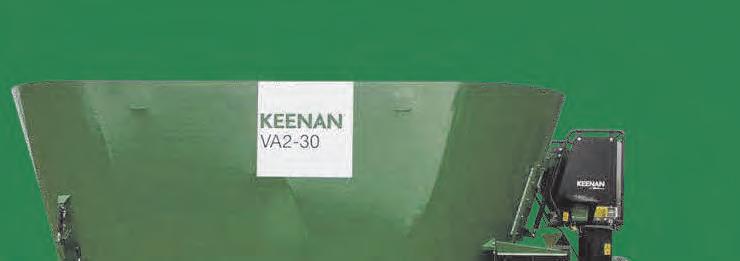
 The Vening family — Jarrod, Lisa, Trent, Shawn and Peter — have invested in a new shed, supporting infrastructure and eight new Lely Astronaut A4 robots, on a greenfield site on their dairy farm at Hedley, in South Gippsland, Victoria.
Since the 1990s, Lisa and Peter Vening have overseen significant change on their dairy farm and have secured an ongoing future for their family.
The Vening family — Jarrod, Lisa, Trent, Shawn and Peter — have invested in a new shed, supporting infrastructure and eight new Lely Astronaut A4 robots, on a greenfield site on their dairy farm at Hedley, in South Gippsland, Victoria.
Since the 1990s, Lisa and Peter Vening have overseen significant change on their dairy farm and have secured an ongoing future for their family.
10 // DAIRY NEWS AUSTRALIA MAY 2024 NEWS ACCURATE MIX CONTROL Every change you make on the farm needs to pay backand a KEENAN diet feeder enables you to make the changes you want for consistency, improved herd healthand yield. Contact us today Phone 1800 KEENAN | Alltechlienert.com.au/keenan WITH IMPROVED PRODUCTIVITY See us at the Australian Dairy Conference Booth#22 119277
Cows wait in comfort for their turn to be milked by robots in the new dairy shed.
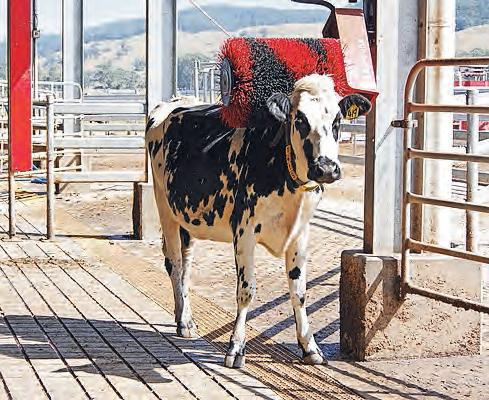


The new shed was built by a contractor. Lely technicians installed the Lely gear.
“Everything else we organised and built ourselves — the new yards constructed alongside the shed, the steel work, the tracks and laneways, the staff room and offices in the shed,” Lisa said.
They enlarged a dam, and the Vening family has used the fill from that to build up a feed pad, currently under construction outside the dairy shed.
Rainwater is captured from the shed roof, stored in tanks and used for the plant wash. Dam water is used for the yard wash, and is recycled into the first effluent pond.
In the vat room, the milk from freshly calved cows is saved and stored in a vat specific for calves. From there, it is decanted into a milk tractor and taken to the calf shed, to feed the calves.
The milk vat has capacity to store two days of milking and when the truck arrives for collection, a bypass tank becomes part of the system.
“While the milk is being pumped out of the
main vat, and its self-clean occurs, the bypass vat holds the milk that’s being collected from the cows,” Lisa said.
When they decided to invest in the Lely robots, the Vening family focused on building up their herd numbers, in readiness for the new dairy.
They also brought some Normande genetics into the Friesian herd.
“For a couple of years we used sexed semen, so we could build up the number of heifers,” Lisa said.
“We couldn’t go higher than milking 420 in the old dairy.
“Once they finish calving this year, we’ll be milking 560 cows. We’ll probably be selling cows now.”
The robots were turned on in May 2023. Lisa said the cows transitioned well into the new system, and while production dropped in the first week, it returned to normal by the second week, a level that has continued.
The herd continues to be split-calving, and in autumn many of the heifers calved and transitioned into the new dairy. Lisa said it was a




longer but safer transition than their experience in the herringbone dairy.
“We’ve been calving for the past three months. It’s so much easier,” she said.
“You don’t have to put cups on. No-one has bruises from being kicked.
“The training for the heifers takes longer, but it’s better for them and for us.
“Having the feed in front of them when they’re in the stall gives the cows and heifers a reward for being milked. And they like that.”
The biggest challenge the family has at the moment is planning the paddock rotations, especially with many of the cows choosing to be milked three times a day.
“Someone is always rostered on for the dairy, and the rest of us are building new fences and laneways,” Lisa said.
“Our biggest challenge is planning the paddocks feed and making sure the cows get what they need. That’s why we’re building a lot of new fences and tracks.
“Cows that want to milk three times a day will have a new paddock they can go to. That


new paddock experience also gives them an incentive to get milked a third time.”
It was easy to transition the herd data from the Jantec system to integrate with the Lely software.
“Every day we have the data on the cows’ health, what they’re milking and how often they’re milking, and if they’re eating properly,” Lisa said.
“If a cow’s milking performance is not what it should be, she can’t hide in the herd.
“We know if a cow is on heat. You can look up how many heats she’s had and when she’s no longer in heat.
“We know from the data on the computer that all the cows are no longer on heat, and they’re calving to the date of their AI.”
In this past year, that data has eliminated the need for their local veterinarian to undertake pregnancy testing in their herd.
After a year of using the robots, the change in milking schedule has enabled more flexibility in the daily work schedule, to focus on tasks like infrastructure maintenance, cropping, pasture management and animal care.
“We’re not all up at 4am milking and having to be there at 3pm for afternoon milking,” Lisa said.
“We don’t have to run around chasing cows and calves.
“If we want to have a bit of personal time we can.”
Although Lisa did say she misses seeing her favourite cows every day, because it is now the cow’s choice when she arrives at the dairy shed.
The Vening family hosted an open day in their robotic dairy in March. For a gallery of photos from the day, go to the Dairy News Australia website at: https://www. dairynewsaustralia.com.au/news/galleryrobotic-dairy-on-show/


 The new shed began operation in May 2023 and has enabled herd growth to 560 cows.
A new feedpad is currently being constructed alongside the dairy shed.
The new shed began operation in May 2023 and has enabled herd growth to 560 cows.
A new feedpad is currently being constructed alongside the dairy shed.
// 11 DAIRY NEWS AUSTRALIA MAY 2024 NEWS *$5,000 factory rebate is only available on new Bobcat TL43.80HF telehandlers. Not available in conjunction with any other offers. Terms and conditions apply. For further details, contact Clark Equipment. Distributed by www.bobcat.com.au | 1300 736 848
Cow comfort at the new dairy shed includes the Lely Luna cow brush.
GRASSLAND SOCIETY’S FUTURE AT RISK
The future of a society that has connected farmers, scientists and agricultural consultants for 65 years is on the line.
The Grassland Society of Southern Australia (GSSA) is planning its annual conference in Bendigo on July 17 and 18, and president Tim Prance says failure to attract sufficient numbers or post a profit could lead to the society’s demise.
“We are committed to revitalising the society, but it requires drastic measures and support from members,” Mr Prance said.
“Failure to succeed may lead to the society's closure.”
GSSA has successfully promoted the business of grass, science and farming
for 65 years with six branches in Victoria, South Australia and southern NSW.
The board recently reconfirmed the GSSA purpose ‘to cultivate a network within the south-east Australian pasture-based industry, fostering informed, evidence-based business decision making’ and vowed to fight for its future.
Mr Prance said he believed there was still an important role for the society but it needed more support.
“We want to ensure the Grassland Society thrives but to do that we need member support otherwise we won’t be around for much longer.”
Mr Prance said volunteer efforts had sustained the society but changes in
government regulations resulting in additional compliance costs, along with reduced government support, had led to more reliance on paid staff.
“We have hired an executive officer to boost income and governance, but challenges persist, and volunteer participation has declined.”
Mr Prance said project income was slow, COVID-19 disrupted events, volunteer shortages led to cancelling the 2023 conference, and regional branches struggle due to lack of volunteer support.
He said cancellation of the 2023 conference had impacted membership and finances.
“A lot of members come from
conferences and the fact that we didn’t have a conference last year meant no new members and a lot of existing members didn’t renew.
“This year we need a well-attended and profitable conference and to cover expenses through memberships and sponsorships.
“We have trimmed costs as much as possible, including changes to office management, membership database and website maintenance, but we need our members to get behind us if we are to survive.”
To register, visit https://www.grasslands.org.au/, call 1300 137 550 or email conference@grasslands.org.au
Watt backs dairy industry
BY ANDY WILSON
DAIRY LEADERS have welcomed recognition from Federal Agriculture Minister Murray Watt of the importance of the dairy industry’s contribution to Australia.
Speaking at the government-hosted National Dairy Symposium in Melbourne on March 22, Senator Watt highlighted the government’s commitment to supporting the $17 billion Australian dairy sector.
“Dairy is Australia’s third largest agricultural industry, and we will continue to do everything we can to support Australian dairy producers and processors, even when that means making tough decisions,” he said.
Senator Watt reiterated the government’s decision to reject the trade deal with the European Union last year.
Negotiations for a free trade deal between Australia and the EU, worth about $100 billion,

stalled in October, 2023.
The Australian dairy industry backed the decision to walk away from the deal.
The symposium, which was a pledge made by the government at the last federal election, tackled issues facing the industry, including productivity and growth, and sustainability and climate.
Australian Dairy Industry Council chair Ben Bennett said the industry was “heartened’ by

the minister’s support.
“Dairy is a product of choice for Australian consumers, and indeed for many international markets,” Mr Bennett said.
“Every one of the industry’s current challenges presents an opportunity and on Friday, our industry made an important step to working together to drive positive change.
“It is now important that government and industry chart a path forward that ensures the resilience, viability and prosperity of Australian dairy for generations to come.”
ADIC deputy chair John Williams said the minister’s announcement to commit funds to Dairy Australia to conduct workshops to explore the productivity challenge was fantastic news for an industry that is crucial to the economy and regional communities.
“We truly believe there are strong opportunities for profitable growth in the Australian dairy processing sector, with a stable domestic market and growing global demand for high
quality dairy products,” Mr Williams said.
Senator Watt also said the Dairy Code of Conduct would need a review in the near future and invited those working in dairy to contribute to a current discussion paper.
The voluntary Dairy Code of Conduct came into effect on January 1, 2020 to address transparency of milk pricing, bargaining power and sharing of price risk across the supply chain.
Senator Watt said the code had changed the way the dairy industry operated, and he announced at the symposium that consultation for a second review will start in September.
“The code was first reviewed in 2021 and found to be operating as intended,” he said.
“It’s put trust back into the industry and helped strengthen the relationships between producers and processors.”
More information on the discussion paper can be found at: https://haveyoursay. agriculture.gov.au/industry-comments-onthe-operation-of-the-dairy-industry-code

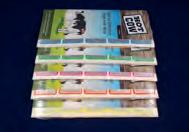
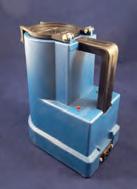

12 // DAIRY NEWS AUSTRALIA MAY 2024 NEWS 0430 016 044 FLEXIBLE, NON-FRAY SILAGE COVER. 10 YEAR UV STABILITY GUARANTEE. NO TYRES OR MESS. REDUCE PLASTIC USE. THIS OFFER WILL NOT LAST - ACT NOW! SILAGE COVERS WHOLESALE DIRECT SECURECOVERS.COM.AU CGS ELECTRO-EJACULATOR & BULL PROBE • An electronic control unit with vinyl jacket and carry strap Rechargeable sealed 12V Battery & 240V Battery charger Various probes and spare parts available CITO THAW UNIT Electronic 12-220-Volt AC digital unit heats and maintains accurate water temperature for thawing. Includes: Glass lined thermos, adjustable heat settings, accurate thaw monitor temperature indicator, fitted retrieval basket, power cord STOCK AVAILABLE: CONTACT THE OFFICE ON 1800 6147 860 FOR PRICING STOCK AVAILABLE: CONTACT THE OFFICE ON 1800 647 860 FOR PRICING OR CONTACT YOUR LOCAL SALES REPRESENTATIVE: VIC, TAS & S/W NSW - NOEL FORREST - PH: 0402 432 771 CENTRAL NSW - CHRIS MEIKLEJOHN - PH: 0427 310 245 QLD & NTHRN NSW - TIM KIRK - PH: 0427 078 048 ELECTRONIC 12-220 -VOLT AC DIGITAL UNIT Heats and maintains accurate water temperature for thawing. Includes: glass lined thermos, adjustable heat settings, accurate thaw monitor temperature indicator, fitted retrieval basket & power cord. HOTCOWTM HEAT DETECTION TAGS • Accurate, easy-to-use tag for detecting cows in standing heat • Available in five colours: Blue / Green / Pink / Red / Yellow
The Federal Government hosted a dairy symposium in March.




























� inner body temperature (± 0.01 °C)
� drinking cycles and water intake with TruDrinking™
� rumination with TruRumi™
� heat detection including insemination window
� abort detection
� calving prediction (~15h in advance)














Discover your hidden potential with smaXtec! With smaXtec you increase herd health AND profitability!
� feeding tool with ration groups
� optional: pHmeasurement
THE HEALTH SYSTEM.
Lallema
Nutrition
Phone: (07) 5451 0125
Email: LAN-Aus@lallemand.com
HEALTH FEEDING REPRODUCTION
nd Animal
·
·
MORE!
CONTACT US FOR
Prime Dairy hits farm target
PRIME DAIRY has an unconditional contract to acquire a 700 hectare ‘inside the gate’ dairy farm at Woolnorth, north-west Tasmania, the latest acquisition as part of a buying spree in the region which the group started in 2020.
Prime Dairy is the dairy arm of Melbournebased fund manager Prime Value Asset Management, which also manages agriculture, equities, income securities, direct property and other alternative investments.
Kirsti Keightley, general manager of dairy investments for Prime Dairy, said the latest purchase finalises the dairy assets for the Prime Value Dairy Trust, which closes to new investors on June 30.
“We have achieved what we set out to do in 2019, having built a dairy business across 5000 hectares in north-west Tasmania and southwest Victoria, and have enough land to have reached our goal of 10,000 dairy cows,” Ms Keightley said.
“This latest ‘inside the gate’ purchase adds significantly to our Tasmanian holdings, which are some of the best dairy producing land in Australia.”
Prime Dairy built its Tasmanian presence in earnest when it acquired 11 ‘outside the gate’ farms from Van Dairy in 2021.
Since then, Prime Dairy committed significant capital expenditure which is now delivering strong dairy production.
“We’re now seeing the rewards from significant investment in the region, which we first commenced in 2020 and ramped up in 2021,”

Ms Keightley said.
“Our dairy production was up 35 per cent over the last year, which will improve profits, and we expect significant further growth to come.
“We now have the assets to grow more grass and to achieve more high quality dairy production.
“There is enough support land to winter all our cows and to grow young stock.



“We have built huge new effluent dams and pivot irrigations, and have significantly reduced the need for chemical fertilisers.”
Ms Keightley said the supply and demand dynamics in Australia would continue to support dairy farmers.
“Australia has a growing population and needs 70 to 75 per cent of its dairy production just to meet local demand. There is also a strong export market for more quality dairy product.
“These dynamics, along with the Dairy Code of Conduct and the minimum dairy price are driving more growth and confidence across the industry.”
The Prime Value Dairy Trusts target a minimum 12 per cent return over the medium-tolong-term, including distributions of 5-7 per cent paid quarterly, with returns derived from a combination of regular income from milk sales and land value appreciation.



on slugs &
• Next generation, iron-based, all weather slug & snail bait with technology for maximum attractiveness, palatability and persistence
• Gentle on the environment, crops and non-target organisms
• Nil withholding period for grazing and harvest
• Certified input for organic production
14 // DAIRY NEWS AUSTRALIA MAY 2024 NEWS ®Registered trademarks. 240124 Iron-fisted
Gentle
environment.
Prime Dairy’s latest purchase in Tasmania (pictured) means it has enough land for 10,000 dairy cows.
snails.
on the
Dayboro’s last dairy farm saved
DAYBORO’S LAST remaining dairy farm will stay in the Bradley family for another generation with the help of the Queensland Rural and Industry Development Authority.
Forty-five kilometres north of Brisbane, the small town of Dayboro was once a thriving dairy hub, but as dry conditions and low milk prices set in, dairy farmers quit the industry, leaving all but one.
Joe Bradley grew up watching and mirroring his parents on their dairy farm and has since dedicated his life’s work to the farm business.
When conditions turned in recent years, he was determined to keep four generations of family legacy alive.
“It’s been tough to survive getting low milk prices, and we’ve also been hit by drought, floods — you name it, and we’ve copped it, but we’ve managed to stay in farming,” Joe said.
Joe’s unwavering resilience is now paying off, with the producer, who is also the president
of dairy advocacy group eastAUSmilk, enjoying increased milk prices as the dairy industry bounces back.
“I am positive about the future of the dairy industry. Prices have improved and yes so have input costs, but all in all I’m confident about what’s to come,” Joe said.
The positive market outlook has given Joe the confidence to purchase the family farm he’s been managing for more than 30 years with the help of a First Start Loan from QRIDA.
“I wanted to keep dairying and I am lucky enough that my daughter and two sons-in-law wanted to keep the business going as well,” Joe said.
“I just love working with animals and being able to supply quality dairy products for the consumer.”
Now Joe is focused on growing the family business, and ensuring his community of Dayboro has a resilient dairy operation to outlast the good and bad times.

“My goals are to pay off the debt from the First Start Loan and to own my property outright,” Joe said.
“I also want to improve the quality of cattle in our herd and continue building a positive relationship with our regional Queensland milk processor.”
Joe said QRIDA south-east Queensland regional area manager Brian Coe helped him complete his loan application.
“Brian contacted me, and we went through it all together. He has visited my farm a few times and helped me work through some questions I had about the loan initially which was very, very helpful,” Joe said.
“I would recommend QRIDA to other farmers. QRIDA is only a phone call away and the support they can provide producers with is invaluable.”
Brian said now was the perfect time for dairy farmers to invest in their operation to ensure they remained on top of their game.
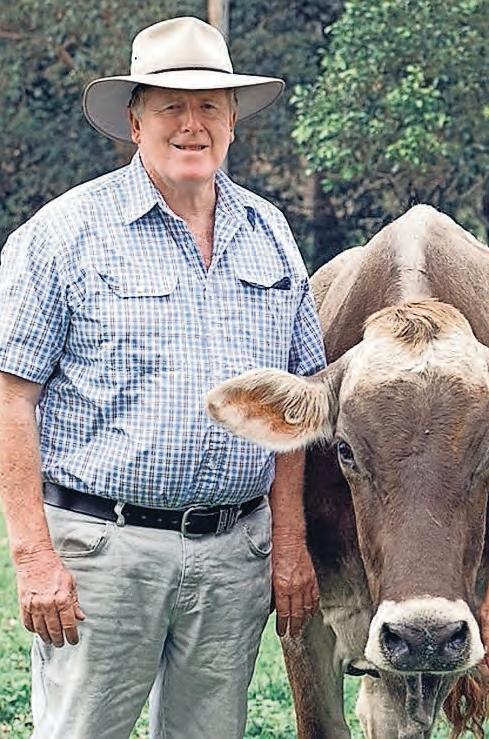
“QRIDA’s First Start Loans of up to $2 million can help dairy farmers get started in the industry and rationalise family partnerships,” Brian said.
“You could also use QRIDA’s First Start Loans and Sustainability Loans to invest in new dairy equipment and machinery, property development works, improve fodder storage facilities, build your dairy cattle herd and purchase additional land, and more.”
ɋ For more information about how QRIDA’s loans could help you establish your primary production business or take over the family farm, visit qrida.qld.gov.au or phone 1800 623 946.
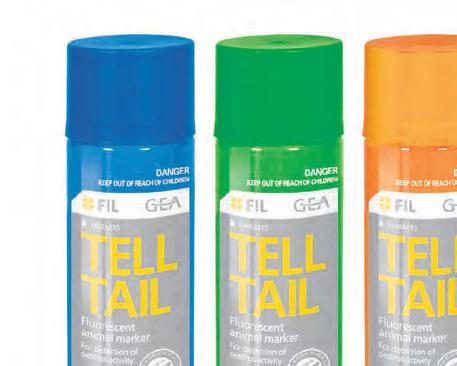
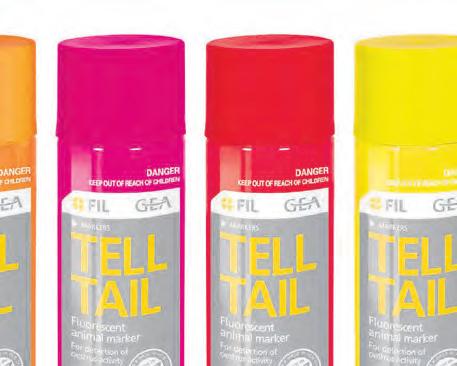



 Dayboro dairy farmer Joe Bradley.
Dayboro dairy farmer Joe Bradley.
// 15 DAIRY NEWS AUSTRALIA MAY 2024 NEWS
QRIDA south-east Queensland regional area manager Brian Coe.
Norco milk wins award
DAIRY CO-OPERATIVE Norco is celebrating its success at the Australian Grand Dairy Awards for the sixth consecutive year.
Norco Lactose Free Full Cream Milk made its way through a rigorous judging process to be crowned Champion in the Modified Milk category in the 2024 awards.
Norco CEO Michael Hampson said it was an honour to be recognised as one of the best quality milk producers in Australia.
“At Norco we see your co-operative members as champions and this award is testament to Norco’s high quality standards and dedication to create fresh, great tasting dairy,” Mr Hampson said.
“From a product innovation perspective, we are always thriving to deliver great tasting, quality produce even to consumers who can’t drink milk, whilst offering additional revenue streams to our hard-working farmer members.
“Our farmers live and breathe dairy so it’s truly a great accolade to celebrate our people’s efforts.”
Norco farmer Warren Gallagher, from Clunes in NSW, said it was fantastic to be acknowledged in the Australian Grand Dairy Awards.
“We are mighty pleased to be recognised

on a national scale for our great tasting, fresh, quality milk — again,” he said.
“Although for us farmers, it’s all in a day’s work, the award really does make us smile and reminds us why we’re in this industry.
“We are proud to partner and work with a processor that is so dedicated to supporting us day in and day out.”
Norco Real Iced Chocolate and Norco Pure Jersey Milk won awards last year.
The Norco Lactose Free Full Cream Milk can be found at Woolworths, Coles and selected independent supermarkets.







DON’T WORRY, BE HAPPY
By JEANETTE SEVERS
He’s the Holstein calf born with a happy face, and that hasn’t changed in the past year.
Happy, the Holstein bull calf born with an emoji happy face on his side, became a public and media star after he took up residence at Lardner Park in Gippsland as a poddy.
Happy was born on a dairy farm at Ripplebrook in March 2023.
He was given to Lardner Park — where the Farm World field day is held each year — for a donation of $10,000 to the local hospital.
He was quickly joined by two paddock mates of the same age — Alan and Eddie.
Subsequently, Happy has become a
very popular mascot for Lardner Park.
During Farm World in March this year, many attendees at the field days made a point of visiting Happy, to wish him happy birthday and donate further funds to the West Gippsland Hospital, based at nearby Warragul.
Lardner Park CEO Craig Debnam confirmed gold coin donations from the public for Happy’s first birthday totalled $595.
A further donation of $150 from Mark Wilms — who donated his prize money from the Tractor Competition held during Farm World — took the total to $745.
Craig Debnam said the Lardner Park Board of Management voted to match the total and round it up to $1500.
Happy continues to inspire people and organisations involved with Farm World.





























Power Systems Australia are the Australian AKSA distributor for a large range of Diesel, Gas & Hybrid generators for stand-by and prime applications. No matter what style or size of generator you are looking for, Power Systems Australia are your Generator specialists.

Systems Australia Pty Ltd 1300 453 054 3 Holcourt Road Laverton North Victoria 3026 www.powersystemsaustralia.com.au sales@powersystemsaustralia.com.au




 Warren Gallagher is a Norco farmer from Clunes in NSW.
Warren Gallagher is a Norco farmer from Clunes in NSW.
16 // DAIRY NEWS AUSTRALIA MAY 2024 NEWS
Happy (right) with one of his paddock mates, Alan, who were one year old in March 2024.
CONTACT
TODAY
A FREE QUOTATION
Power
US
FOR
Make hay while sun shines
THE AUSTRALIAN Fodder Industry Association says there are significant missed opportunities which could address drought preparedness and resilience across Australian agriculture.
The AFIA’s Fodder Research, Development and Extension Stocktake report says where fodder R,D&E is under way it is often fragmented, results and knowledge gained are not being broadly shared between researchers and agriculture sectors, and collaboration is minima
“Fodder is a critical resilience tool, yet this appears not be broadly recognised,” AFIA chief excutive officer Paula Fitzgerald said.
“In times of drought and flood, governments often take reactionary approaches to fodder, particularly to support animal welfare needs, yet we believe the greatest opportunity exists outside of crisis times,” she said.
“It is understandable that fodder is often viewed through a specific commodity lens, but we believe there are benefits to be had in collaboration and the sharing of research outcomes.
“We need a critical mass ‘focus on fodder’ and recognition of its importance as a resilience tool. Despite significant funding for drought preparedness, there appears to be minimal focus on the national importance of fodder and the critical role it plays.”
The report listed four key areas of opportunity:

Make hay while the sun shines
Identify mechanisms to encourage growers to make hay during ‘good times’ in preparation for challenging times such as drought and flood.
The cost of de-stocking and re-stocking is significant (both livestock and genetics).
De-stocking often occurs because of anticipated rising feed costs, yet if fodder was available on-farm, this cost could be reduced.
Optimise opportunity
Provide learning opportunities for growers to facilitate education on the best methods for cutting, curing, baling and storing hay, with a strong resilience focus in terms of producing a high-quality product (resulting in better nutritional value) and minimising pest attack.
KEEP WARM THIS WINTER AUTUMN SPECIAL
The past decade has seen a doubling of on-farm storage for grain, the opportunity is how to address this for fodder (hay and silage).
Tackle
low hanging fruit
Identify the key elements causing hay fires and develop a ‘toolkit’ to manage and reduce this risk.
From the September 2023-February 2024 period, AFIA collated 48 hay fires across the country.
Hay fires have significant impact in terms of fodder loss, infrastructure (sheds and machinery) destroyed, resources of emergency services personnel, and livestock impact in terms of reduced fodder availability.
While some research is focusing on particular production points, there is a need for an ‘all of production cycle’ focus.
New tools
Encourage technology experts to work with the industry, utilising their skills, to develop tools which target industry priorities and in turn, reduce risk and improve confidence in the fodder sector.
“Some of the issues identified through the stocktake report, such as quality and hay fires, have been largely left unaddressed for decades,” Ms Fitzgerald said.
“Now is the time to focus, invest and solve.
“In addition to these report findings, we have anecdotal evidence from our members, that fodder production carries with it greater risk, compared with the production of alternate crops.
“This increased risk comes as a result of the time from production to sale (unlike grain, fodder is rarely sold ‘straight off the header’), fodder producers having to store and market the product themselves in a deregulated market, and the increased weather risk due to the curing window length.
“We believe this situation needs further assessment, as it comes at a time when dairy and livestock businesses are looking to grow,” she said.
“A decline in fodder production, as a result of farmers choosing alternate crops, would present the broader agriculture sector with a significant challenge.”
The report can be found at: https://afia.org. au/fodder-r-de-stocktake/



// 17 DAIRY NEWS AUSTRALIA MAY 2024 NEWS ® HERE FOR YOU. WORLD WIDE SIRES Phone (03) 5831 5559 • info@wwsaustralia.com wwsaustralia.com Product of the USA
The Australian Fodder Industry Association has released its Fodder Research, Development and Extension Stocktake report.
RECEIVE A FREE WWS JUMPER WITH THE PURCHASE OF 100 UNITS OF ANY WWS SEXED
UNITS OF ANY WWS CONVENTIONAL SEMEN WHILE STOCKS LAST CAPPED AT FIVE UNITS OF MERCHANDISE PER ENTERPRISE
OR 200
Humus hydrates healthy soils
BY DR LES SANDLES
WITH WINTER looming, I aim to pull a few threads from previous articles together, and then explain the vast difference between how soil water behaves in degraded compared to healthy soils — I guarantee, you will be astounded!
The importance of Ca and Mg in managing soil pore space cannot be over emphasised. Ca separates soil particles and Mg pulls them in tight.
As Mg is much stronger in attracting and attaching to particles, Ca needs a little help from S to prize Mg off the particle (which is why gypsum is so useful).
The ideal is 68 per cent BS for Ca and 12 per cent BS for Mg as this ratio optimises the all-important soil pore size, allowing for roughly equal parts water and air to occupy the pores in the soil at field capacity.
The interaction between water and air in
these pore spaces is critical for detoxifying oxygen and transporting it into the rhizosphere (the 1mm zone in which plant roots, microbes and soils plant roots play).
A 6 micron pore space maximises oxygen transfer (dissolution) from air to water preventing death and destruction of vital soil microbes and the rhizosphere, respectively, as both require strictly anaerobic conditions.
Soil pore space also provides room for humus to do its thing — expanding and contracting to manage water and nutrients.
Despite comprising only 1 per cent of the soil mass, humus has incredible impact on the way a soil performs, particularly in respect of soil water management which we can liken to a sponge soaking up water.
In a healthy, well-structured soil, humus will hold seven times its own weight in water. In a tight and/or unhealthy soil, it barely holds a drop.
Now for the interesting stuff.
At college, we learnt all about the important
SKIOLD DISC MILL TAKE CONTROL OF YOUR FEED

role of pore size in holding water (larger pores) and drawing that water through the soil via ‘capillary action’ using surface tension among other factors to draw water from areas beyond the plant root into the root zone. This makes perfect sense — we see it all the time with the soil surface dry and the lower reaches progressively more damp.
We fresh-faced students of the 1970s and early ’80s swallowed this bullshit unquestioningly as it was served up with such conviction. I have now learnt otherwise. We had no concept our soils were already so degraded that it made this true.
In a healthy soil, water management operates in a vastly different manner!
Healthy soils abound in microbial life, and as such there are oodles of tiny protein building blocks (amino acids) coming and going as microbes grow and decay.
These ‘free’ amino acids act like glue to weakly bind water within the convolutions of the complex humic structures. The more
microbial activity in the soil, the more amino acids available which, in turn, bind more water to the humus — up to 7 per cent of its weight. When this occurs, the humus acts like a battery.
When we turn the key and draw some current, the charge in the battery instantly re-equilibrates throughout. Likewise, when the plant draws some water, the rest of the water redistributes throughout the entire connected soil profile.
This ensures that at least seven times the water is available to plants in a healthy soil compared to soils that are compacted or degraded.
Dr Les Sandles is a renowned thought leader and provocateur in the dairy industry. Best known for his role in revolutionising nutritional and pasture management practices, Les has turned his attention to the ‘last frontier’ — transmogrifying the forage production system into a C-munching machine. Contact him at: info@4sight.bioif
WORLD-FIRST LOW-EMISSION MILK



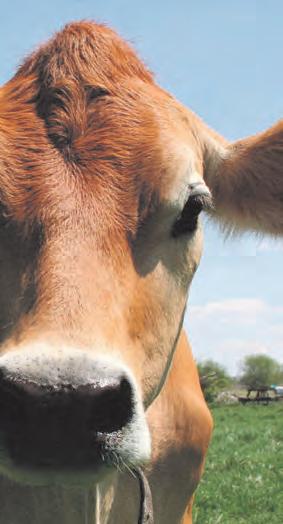
Tasmanian dairy producer Ashgrove, in partnership with Sea Forest, has released the world’s first commercially available low-emission milk, Ashgrove Eco-Milk.
The partners said this pioneering product represented a significant leap forward in the decarbonisation of the dairy industry.
The product is now available on shelves in Woolworths, Coles and IGA supermarkets across Tasmania.
Ashgrove Eco-Milk delivers the fullcream milk experience, retaining its taste and quality while reducing methane emissions.
This achievement is possible through Ashgrove’s innovative partnership with Sea Forest, a fellow Tasmanian company.
“Partnering with Ashgrove to launch the world’s first low-emission milk is a remarkable milestone for Sea Forest,” Sea Forest CEO Sam Elsom said.


“This pioneering collaboration demonstrates the potential of our methane-mitigating feed product, SEAFEED, to revolutionise the dairy industry globally.



“We are committed to working with partners like Ashgrove to expand this technology and empower consumers worldwide to make sustainable choices while enjoying delicious and nutritious milk.”
Sea Forest, a global leader in Asparagopsis seaweed cultivation, has developed SEAFEED — a revolutionary feed product with the potential to reduce methane emissions from livestock by up to 90 per cent.
By incorporating SEAFEED into their cows’ diet, Ashgrove significantly lowers its herd’s methane footprint without compromising milk quality.
“Ashgrove is proud to be at the forefront of this global challenge, offering a solution rooted in Tasmanian innovation,” Ashgrove managing director Richard Bennett said.
“Eco-Milk embodies our unwavering commitment to environmental stewardship and community wellbeing.”
SEAFEED has been used across commercial farming and feedlots for the past three years and is backed by more than 30 peer-reviewed studies.
Ashgrove Eco-Milk is Sea Forest’s latest climate-friendly product innovation.

The world’s first commercially available lowemission milk, Ashgrove Eco-Milk.
Sea Forest has also partnered with Grill’d to create the game-changer burger, the world’s first sustainable grass-fed beef burger.
Sea Forest is also partnering with Fonterra, Asahi and MJ Bale to reduce methane emissions across multiple industries and product lines.
Beyond SEAFEED, Sea Forest is actively developing a range of Asparagopsis seaweed-based products with applications beyond the livestock industry.
These innovations target various sectors, including nutraceuticals, bioplastics and biofuels, offering a holistic approach to sustainability.
18 // DAIRY NEWS AUSTRALIA MAY 2024 NEWS
SKIOLD VMS
CLASS LEADING
MILLING TECHNOLOGY
EUROPEAN
DISC MILL SIZES AVAILABLE www.vacmillsolutions.com.au Email: sales@vacmillsolutions.com.au CALL US TODAY: Tel: 07 55 477 588 SPEAK TO A SKIOLD VMS REPRESENTATIVE ABOUT YOUR NEXT FEED MILL Flexible Augers • Pencil Augers • Mixers • Cleaners • Control Systems Complete feed systems also available
GRAIN
UNPARALLELED MILLING EFFICIENCY AND ENERGY CONSUMPTION BETTER UTILISATION OF YOUR GRAIN
QUALITY AND MANUFACTURED MULTIPLE




















































Zero upfront costs. One powerful dairy monitoring system. Allflex® SenseHub® Dairy Monitoring SUBSCRIPTION NOW AVAILABLE Scan the QR code to get in contact with your local Allflex® SenseHub® Dairy monitoring expert, call 1300 138 247 or visit www.allflex.com.au This product is not intended to diagnose, treat, cure, or prevent any disease in animals. For the diagnosis, treatment, cure, or prevention of disease in animals, you should consult your veterinarian. The accuracy of the data collected and presented through this product is not intended to match that of medical devices or scientific measurement devices. ® Registered trademarks. Copyright © 2023 Merck & Co., Inc., Rahway, NJ, USA and its affiliates. All rights reserved. Allflex® dairy monitoring systems are now branded SenseHub® Dairy, backed by dedicated research and development by MSD Animal Health. Unparalleled heat detection. $ Alerts for at-risk cows. affordable payment per cow per month. Whole-herd nutrition and transition insights.

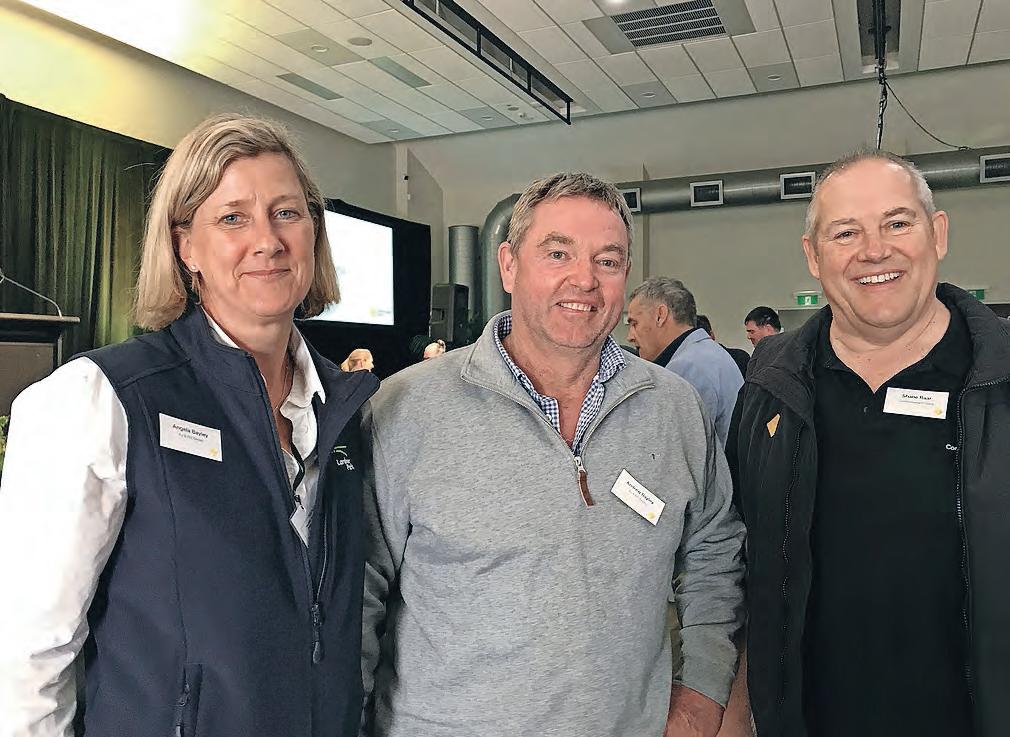
Crowds flock to field days
BY JEANETTE SEVERS
PEOPLE CLIMBED aboard tractors, looked under bonnets, craned their necks to see up to the cabins of some machines, assessed the volume capacity of different sprayers, and generally caught up with friends and neighbours.
There were cattle to view, sheepdogs mustered and worked sheep, exhibitors contested the tractor backing competition, attendees could ride camels for real, or visit farms using virtual technology, and the National Centre for Farmer Health staff were busy with farmers seeking health checks over the three days.
Farm World field days, on March 22 to 24, attracted a lot of farmers serious about viewing the latest machinery and equipment available for their business.
This year, there were 750 brands and exhibitors represented — which Lardner Park chief executive officer Craig Debnam said was a larger number than recent years.
“Agricultural dealers reported strong sales each day and have generated promising inquiries and leads for the future,” he said.
“We saw 34,881 patrons attend, along with about 2000 exhibitor staff.
“This is a fantastic result in the current economy.”
Farm World generates significant funds that are returned to the local community, through service clubs, schools, the hospital and charities.
“Many Farm World exhibitors are local machinery and equipment businesses, and their involvement, and the many visitors, stimulates the local economy,” Craig said.
“Local service clubs, schools and charities all provide services at Farm World as major fundraisers for their groups.
“This financial support, provides important funding back into the community we all love and live in. It’s a win-win relationship, every year.”
Farm World is the result of hundreds of hours of voluntary organising work.
“Farm World is built on strong relationships,” Lardner Park Board of Management chair Angela Bayley said.
“There are 12 board members and 25 committee members, supported by a team of five staff.
“Lardner Park hosts 106 events throughout the year, and Farm World is one of them. This year, Farm World celebrated its 57th year.
“Among our longest existing exhibitors are
ONLINE GALLERY
Dairy News Australia’s busy Gippsland correspondent Jeanette Severs took more photos at Farm World than we can fit into our print edition.
Please go to our Gallery | Farm World 2024 at https://www.dairynewsaustralia.com.au/ to see loads more images from this great three-day event.
It’s free to visit our website, so make sure you have a look.


Evans Petroleum, Vin Rowe Farm Machinery and Warragul Toyota — all are local businesses — and CommBank.
“Lucas Mill started exhibiting portable sawmills at Farm World 30 years ago, and now they sell globally.”
There were information events to attend, as well as the 750 exhibitors to visit.
“This year, Friday started with breakfast for 200 people, hosted by CommBank, then 120 women attended Telstra’s Women in Agriculture lunch,” Angela said.
At the Telstra Women in Agriculture lunch, she spoke about Angela Betheras, the late patron of the lunch, who passed away in the weeks after Farm World 2023.
Angela Betheras was the first woman chair of Lardner Park’s Board of Management and instigated the annual Women in Agriculture lunch at Farm World, to encourage women to attend the field days.
The key speaker at this year’s women in agriculture lunch was VFF president Emma Germano.
Breakfast attendees listened to a panel of speakers discuss succession planning.
“A lot of people who attend Farm World are seeking new information from the exhibitors,” Angela Bayley said.
“CommBank hosts an afternoon discussion about a topic of importance to the agricultural sector. This year, it was carbon sequestration.
“CommBank also supports Yarn at the Farm, where we announce the winners of the Farm World awards.”
This year, Best Overall Exhibit was presented to Brandt Tractors. The award was sponsored by TAFE Gippsland.
Other award winners were:
ɋ The Clive Walkinshaw Perpetual Award, for the Best Cattle Pavilion Stand, was presented to Canaan Ranch. It was sponsored by Alex Scott and staff.
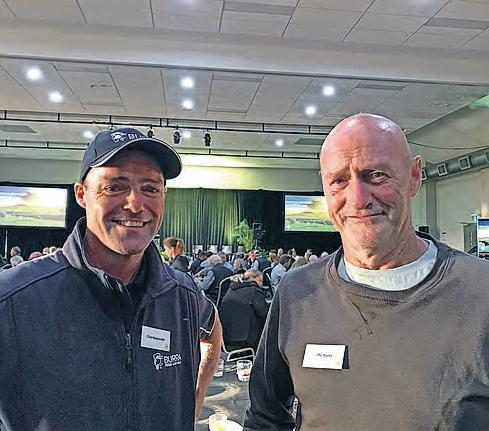

The Best Overall Exhibit at Farm World 2024 was presented to Brandt Tractors. Demonstrating the talent that supported them winning the award, Brandt Tractors’ Brandt Tractors’ Adam Chalmers was keeping the maize watered, in front of the John Deere self-propelled forage harvester.
ɋ John Schelling, representing Evans Petroleum, presented the Best Agribusiness Exhibit to Gallagher Australia.
ɋ Turnbull Motors’ exhibit received the Best Recreation and Leisure Award, sponsored by CommBank.
ɋ The Best First Time Exhibitor award was presented to Gippsland Timber Gates, sponsored by Baw Baw Shire.
ɋ TracMac Farm Equipment received the Best Technology and Innovation Award, sponsored by WIN TV, for a new machine for feeding out large bales (see page 31).
ɋ Bandalee r Brewing was named the Best General Interest Exhibit, sponsored by Warragul Toyota and Ag Farm Machinery.
“The hard work of the Lardner Park board and committee remain focused on delivering a valuable event for our community, and we extend our thanks to all who exhibited, attended, and supported Farm World,” Craig said.
At the TTMI site, Case IH tractors were attracting attention.
Clint Newcombe from Burra Foods and Phil Bate from Toorong were at Friday’s breakfast.
CommBank’s general manager Victoria and Tasmania, Dominic Westendorf, and AgriSustainability manager Carmel Onions, with Lardner Park CEO Craig Debnam.
At the Friday breakfast were Lardner Park Board of Management chair Angela Bayley, dairy farmer Andrew Bayley, and CommBank’s relationship manager Shane Raar.
20 // DAIRY NEWS AUSTRALIA MAY 2024 FARM WORLD 2024
Some of the equipment and machinery exhibitors with their awards.
Meeting challenges head-on
BY JEANETTE SEVERS
REMAINING TRUE to yourself and being authentic was the theme of the keynote speaker at the annual Women in Agriculture lunch, at Farm World on March 22.
The theme would have fitted well with the overall intention of the lunch, which was established by the late patron, Angela Betheras, during her time as Lardner Park Board of Management chair. Lardner Park is the setting for the Farm World field days.
Angela Betheras established the lunch to welcome women to Farm World and encourage them to network and support each other.
Speakers over the many years of lunches have included journalists, farmers, agribusiness principals, and leaders of charity organisations and other businesses — all with one thing in common: they are women.
Angela passed away in the weeks following Farm World 2023, after a long illness.
She has left a legacy, which was noted by current Lardner Park’s Board of Management chair Angela Bayley in her opening remarks to welcome attendees.
There were two guest speakers at this year’s lunch – VFF president Emma Germano and Cathy McGowan, ex-politician and now author.
They were introduced by Loretta Willaton from Telstra. Telstra sponsors the lunch, which was attended by about 120 people.
Cathy spoke first, talking about the stories she uses to connect to community and her view of agriculture.
“Agriculture has a production side — that’s the blokes,” Cathy said.
“And it has a marketing side — that’s the women.”
Now in the role of AgriFutures Australia Board chair, Cathy encouraged attendees to participate in courses to advance their skills.
She cited examples from her own life, and what she has learned from attending time management, leadership, mediation and dispute resolution training.
“I’m proudly an Australian woman leader,” she said.
“Doing the Australian Rural Leadership Program course taught me how to change my style about how I deal with people.”
She encouraged attendees to “turn up, speak up and step up to be heard”.
Emma Germano talked about being authentic, even when internal and external forces challenged you.
“Being a women in leadership is different to being a man,” she said.
“We are treated differently.
“I’ve been so conscious over my journey of not playing ‘the woman card’.”
But, Emma said just being a woman in a public leadership role meant you were treated differently.
She said every media outlet wanted to be able to tell their story of her trajectory into the role of VFF president.



This meant that often what she was trying to achieve was clouded by perceptions of her as a young woman, of ethnic background, from a minority agricultural sector.
Those perceptions led to personal attacks in public and private that Emma was not prepared for.
“I can see the issues needed to be heard, but it’s harder to get heard when the focus is on me personally,” she said.
Personal vendettas compounded the risk of being ignored when — in her role as VFF president — she was advocating against government policy decisions that closed down food production businesses and even an agricultural industry sector overnight — as happened during and pre pandemic.
“The personal attacks were based on difference — I’m a young woman, I am of ethnic background and I come from what’s perceived as a minority agricultural sector,”

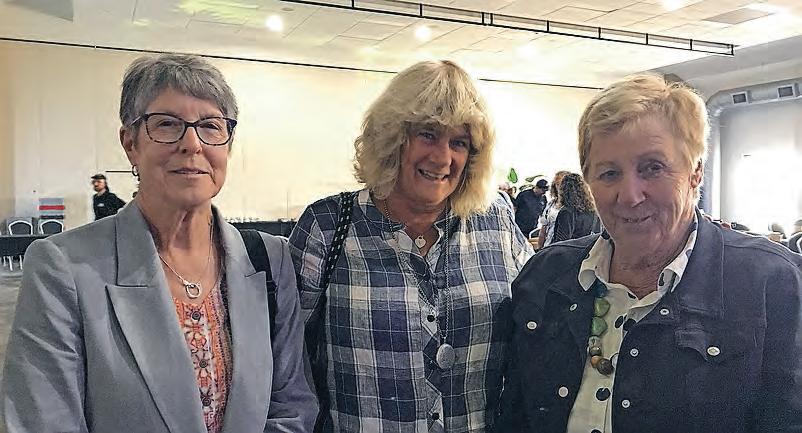
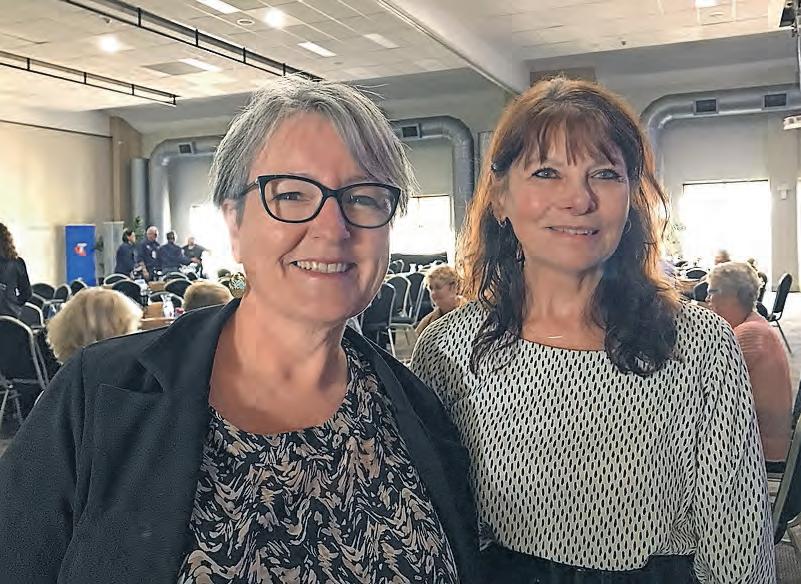
Emma said.
“There were many times when I’d be talking to Dad about how hard it was and he’d say, ‘too bad’.
“He and Mum have taught me that demonstrating leadership is about being authentic to myself.
“In the role of VFF president, I’ve learned that when the culture around us encourages us to not speak up, those who get heard are the extreme voices.
“And they don’t represent the majority of us.
“That means the 80 per cent of us in the middle need to support each other.”
Emma quoted statistics to demonstrate farmers are among the most trusted people in the community.
“People trust us to be concerned about the environment, animal welfare, soil health, safe workplaces and producing healthy food,” she said.
“That trust is unusual to many vocations.
“So, if we let the extreme voices be heard, they represent a disproportionate view of what the community believes and supports.
“That’s why we need your voices to be heard,” she said.
One of the biggest challenges Emma has undertaken in her terms as VFF president, is leading a board of management that wants to change the fundamental way the farmer-member organisation operates.
“The board decided income needs to be higher than expenses,” she said.
“By being accountable for change has meant some of our worst challenges have been from within the organisation.”
Emma said she did not understand how change would feel like a threatening process for some people. Those are lessons she has taken on board, sometimes with humility.
Her main message was to be authentic and ask for authenticity from other people.
“Leadership will be hard,” Emma said.
“But as dad said, ‘too bad’. There’s no golden key, no ideal pathway, you just have to keep on going.
“And you need to support other people around you. You need all types of people in your team.
“Be authentic — that’s what resonates with people.
“This is my final year as president and I thought it would be neat and tidy. It’s still messy.
“But by keeping on going, change inches slowly forward and opponents drop off.
“I’m leaving an opportunity for other people to continue to grow the organisation.”
Emma’s concluding words of advice were to encourage attendees to value diversity.
“We need to enable diversity in thinking and viewpoints to be in the conversation.”
Emma Germano, VFF president and keynote speaker, with Mary Aldred from Warragul, Sarah Lewis from Warrnambool and Lyn Johnson from Warragul.
Robyn Bayley from Trafalgar, Vicky Ingham from Yea and Sue Gilliland from Yarram.
Representing Baw Baw Shire Council at the Women in Agriculture lunch were Mayor Annemarie McCabe and Deputy Mayor Tricia Jones.
Marie Germano, from Mirboo North, with Regional Development Australia chair Kellie O’Callaghan.
Angela Bayley, chair of Lardner Park which hosts the Women in Agriculture lunch, Loretta Willaton from Telstra, which has sponsored the lunch since inception, and Emma Germano, VFF president and keynote speaker at the lunch.
// 21 DAIRY NEWS AUSTRALIA MAY 2024 FARM WORLD 2024
Tricia McNeil from Warragul, Kerry Cougle from Willow Grove and Lisa Wilms from Willow Grove.


Experts help to clear the air
BY JEANETTE SEVERS
UNDERSTANDING EMISSIONS in farming and along the supply chain was part of the discussion at Farm World field days this year, held at Lardner Park on March 22 to 24.
While agriculture was expected to feed the world, and Australia’s farmers and food manufacturers to play a key role in reducing global hunger, there were challenges to do that while reducing emissions that created warming greenhouse gases and contributed to climate change.
At the same time, as other industry sectors reduced their emissions, the agriculture sector exponentially increases its greenhouse gas contribution.
Every year, CommBank holds a public discussion about a key issue related to agriculture.
This year Robert Green, a beef producer and finisher, was asked to contribute his knowledge and experience about understanding emissions and carbon sequestration.
The discussion was facilitated by Commbank agribusiness sustainability executive manager Carmel Onions, who also led a masterclass in understanding carbon and emissions measurement.
CommBank has started a pilot program focused on understanding the online tools available to farmers to calculate baseline emissions, as a step towards understanding what farming practices can contribute to a carbon neutral business.
Carmel said it was important to identify tools that reduced complexity about changing farming practices to enhance natural capital and improve productivity and profitability, while meeting future consumer demands.
One of the complexities is understanding how scope three emissions reduction are relevant to farming businesses, when they are part of the supply chain.
Scope one emissions were produced from farm assets and the farming practice.
Scope two emissions were produced from farm business activities using electricity bought off the grid.
Scope three emissions were caused along the supply chain, but can be related back to the farm business, its practices and assets.
“Other businesses along the supply chain are seeking to meet their own climate commitments and reduce their scope one, two and three emissions,” Carmel said.
“In ecological systems, we now understand that small temperature changes mean a lot.
“Baselining our carbon and emissions gives us an estimation of the greenhouse gases we emit in our businesses.
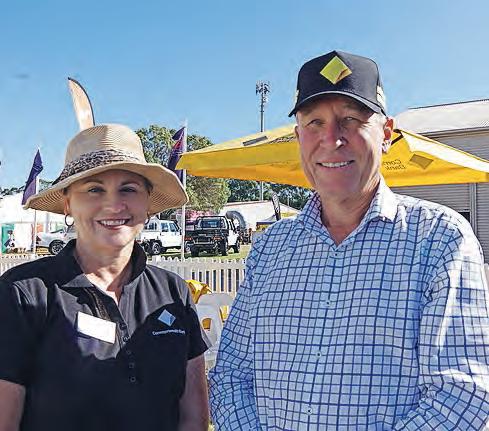

“Measuring our baseline emissions enables us to put together a plan to make a difference on our farms.
“Emissions measurement will become increasingly important to ongoing market access, for taking advantage of export opportunities and to meet supply chain expectations.”
In agriculture, these baseline measurements include methane, nitrous oxide and carbon dioxide.
“The goal is to reduce gross emissions and sequester carbon,” Carmel said.
“At this stage, we’re encouraging farmers to pick a model and measure their baseline.
“After that, they can develop plans for what actions they are going to take to improve their baseline data.”
Calculating their baseline emissions and understanding how this data correlates to their farming practices can mean farmers are in a good position to access discounted finance packages that recognise their investments in improving natural capital, business efficiencies and productivity.
Carmel said the market place was already teeming with sustainable solutions — including using genetics to improve growth of an animal, planting shelter belts on unproductive land and along waterways, increasing shelter for animals, and improving biodiversity.
The solutions adopted depended on the models and tools chosen by the farmer.
The other solution was to utilise activities that sequester carbon, increasing the amount of carbon in the soil.
Robert and Ingrid Green from Bacchus Beef, Tonimbuk, in the aftermath of the March 2, 2019 bushfire that burned through their property, sought knowledge so they could understand how to build soil health, and in
the process found themselves building their knowledge about what to do in their farm business to be carbon neutral.
Their planned practice changes included having a stronger engagement with their supply chain.
The couple own and lease multiple properties, and this enables them to value add to their breeding enterprise, utilising land and a feedlot to fatten and finish livestock; they direct sell their finished product to abattoirs for the restaurant trade.
Robert spoke about their recent journey to baseline measure their emissions data and soil carbon.
This included soil core samples to one metre depth.
“We used the one metre depth as a reference point, because we believe we need to know where we’re starting from to identify the best solutions for our business,” Robert said.
They completed a detailed analysis in 2021, and their plans going forward include five-yearly reviews. Their next detailed analysis will be in 2026.
Measuring their emissions has resulted in establishing tree lines on their properties, changing their beef genetics to breed smaller cattle that finish quicker, and using feeding systems that reduce fodder wastage.
They have also purchased and leased land with an eye to topography that suits their farming activities.
Robert said he and Ingrid aimed to become carbon neutral in their farm business.
“We’re embedding sustainability within our farm operations,” he said.
“The beef industry has set a target of carbon neutrality by 2030.
“Establishing the baseline encourages us to
identify activities we can do and practices we can change to get to carbon neutrality.”
The discussion at Farm World came on the back of a 2019 report released by CommBank that identified climate change could see profitability declines in agriculture, as much as 40 per cent by 2060 in the dairy industry.
Heat stress affecting the ability of cows to lactate and produce milk and lack of rainfall leading to declining pasture quality and quantity would contribute to this reduction in profitability.
Conversely, solutions that included shade and water to help keep cows cool, and utilising technology to reduce overgrazing, would help to maintain productivity within some agricultural systems.
More recently, the Chubb review analysed Australia’s indicators and systems integrity for carbon trading.
The Independent Review of Australian Carbon Credit Units, led by former chief scientist, Professor Ian Chubb, was commissioned by the Federal Government in July 2022.
The review recommended improvements in the accreditation and regulation of carbon service providers and carbon market advisors.
But the Climate Council said the review ignored major greenhouse gas emitters role in buying Australian Carbon Credit Units to offset their emissions polluting practices, rather than change practices.
This has created a market for offsets on paper that can enable landholders, including farmers, to trade their carbon sequestration efforts.
Climate Council Head of Advocacy Dr Jennifer Rayner said if the government did not create reform in the market place, this would enable some polluters to continue their practices, and cheaply purchase carbon credits from farmers.
Carmel Onions was firm in her response to the review.
“Carbon farming is very complex,” Carmel said.
“And I encourage farmers to speak to a lot of specialists, including getting legal advice, about what it means to their business to sell any carbon they sequester or use to offset their own emissions.
“If you sell the value of your sequestered carbon to a business along your supply chain, you can’t use that credit for your own business.”
She said economic highs and lows, such as the cost of living crisis currently being experienced, would always affect the decisions consumers make when buying food.
This included any supposed price premiums attached to food that was labelled carbon neutral or with any other sustainability label.
Carmel Onions, from CommBank, with Robert Green, from Tonimbuk. Robert and his wife Ingrid have been focusing on building soil health and their knowledge about what their farm business needs to accomplish to become carbon neutral.
Tony and Kerral McFarlane, who farm at Modella and Buchan.
Dairy farmers D’arcy McAlpine from Woodside with Aaron Thomas and Dominic Harrison, both from Won Wron.
22 // DAIRY NEWS AUSTRALIA MAY 2024 FARM WORLD 2024
Nils Olsen from Soilkee, Jim Armstrong from Labertouche and Sallie Jones from Gippsland Jersey.




Plan early for your future
BY JEANETTE SEVERS
THE ONGOING growth of agricultural land value in Australia is challenging wealth transfer between generations into the future.
In the recently released ABARES Farmland Price Indicator report, at the start of March, the average price per hectare of broadacre farmland has grown in value by an average 10.09 per cent year on year in the past 10 years. Properties in the high rainfall zone have experienced the highest annual growth rate in the past 10 years, of 10.49 per cent.
ABARES also identified Australian milk production would lift 1.8 per cent to an estimated 8.3 billion litres in this financial year, with individual herd production driving that growth.
Because the farmland price indicator is based against broadacre cropping regions, it is skewed to one type of production, but the region with the biggest growth rate in land values is Victoria’s Wimmera district, followed by west and south-west Queensland, then the Darling Downs and Central Highlands districts, in Queensland.
What this amounts to is the value of agricultural land is growing steadily, and this is a reflection of positive business performance and growth in the farming sector in the past 10 years.
This growth in wealth challenges what has been a traditional norm for transferring agricultural businesses and assets to the next generation, and was the topic of a breakfast-timed panel at Farm World field days recently.
A panel of speakers agreed that planning ahead helps take the emotion out of decision making. It should also take into account the aspirations of the current owners and future generations.
The breakfast panel of speakers has become a regular gig at Farm World in recent years, tackling complex topics specific to the agricultural industry.
This year’s panel speakers were Jacob de Klerk and Suresh Ravichandran from CommBank, Margaret Willett from Willett Lawyers, Ferguson Agribusiness general manager Courtney Ferguson and Matt Harms from On Farm Consultants.
Planning ahead helps to future-proof the business and can take many shapes, CommBank’s regional agribusiness banking general manager Dominic Westerndorf said.
He introduced the topic.
“Farm succession planning — which secures a strong future for the farm — is one of the most important aspects of farm management, but it can be challenging to know where to start,” he said.
“Planning ahead can go a long way towards ensuring the transition is smooth when it is time to retire or pass the business to other family members — or someone else.
“Succession planning should also take into account unexpected events and what should happen within the farm business, and with the
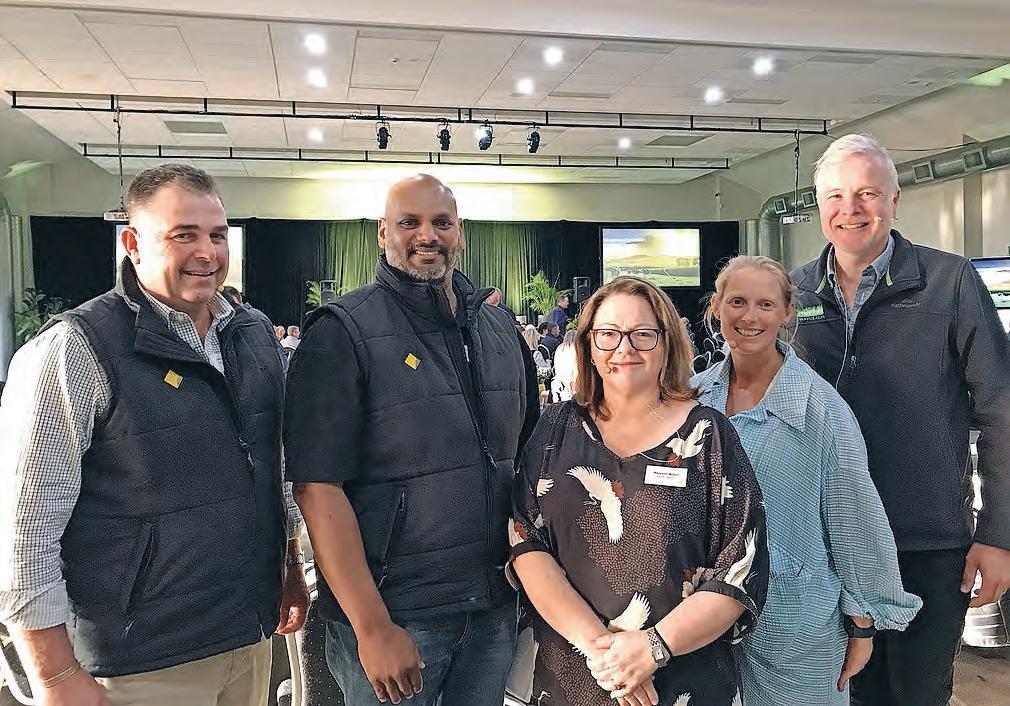
farm assets, if any of the current owners aren’t available to make decisions.
“At a personal level, planning ahead also enables you to manage your private wealth, taxation and retirement plans.”
Succession planning also helped clarify roles and responsibilities within the farm business.
When it took into account the aspirations of future generations, it gave them time to learn the business skills — formally or informally — they needed to contribute to the business.
Dominic said a succession plan also enabled current owners to map out their retirement plans and what, if any, ownership or part-ownership of the business looked like for them.
It also enabled the farm business to cater for the inheritance needs of family members who did not want to be involved in the business.
Defining the business structure was a key part of succession planning, according to one of the panel speakers Courtney Ferguson.
The only farmer on the panel, Courtney is Ferguson Agribusiness general manager, of which has grown from landholdings of 810 hectares to 11,332 ha, diversified into other business including renewable energy, and is structured as a company with formal advisers outside the family.
Courtney, one of three siblings, said every family member contributed to co-designing succession within the business.
With three young children of her own, she said the next generation were also involved in simple discussions about cash flow, business direction and viability.
“I was about 10 years old when my parents and siblings and I had our first conversation about succession planning,” Courtney said.
“I didn’t understand most of it, but my understanding has progressed from there.
“Now my siblings are involving their children in these conversations, as am I.”
Independent business advisers included in those discussions are the bank consultant, accountant and lawyer.
Courtney said it was important to identify the business entity and its assets, as separate to personal wealth.
“With land values now, no-one earns enough to take on that financial risk, by buying all the business’s wealth and assets,” she said.
Ferguson Agribusiness also has an exit strategy for each owner.
“If you don’t have an exit strategy, maybe you don’t have the right people in your team,” she said.
“We’ve set up the business so it has a future beyond the people who set it up.
“That includes keeping an open mind about what the business is investing in.
“Talk about opportunities as they become available.
“We conduct due diligence to identify business opportunities for growth, and some of those opportunities are outside farming.”
Matt Harms said succession planning enabled everyone to think and talk about the type of business structure that would be applicable to their farm.
It also helped manage people’s expectations.
“Succession planning is about transferring business ownership,” he said.
“That transfer can be within or outside the family.
“In succession planning, business wealth may be treated separately to the assets in the business.”
Matt said sharefarming in dairy was an example of succession planning where the assets — land, water licences, equipment, cattle, etcetera — were treated separately, often with different ownership structures, but enabled wealth to grow.
He recommended succession planning

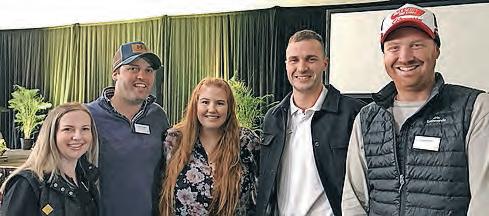
discussions should involve the family as a group, but also individuals separately, and include bankers, solicitors and accountants who advise the family members.
“It’s important to clearly identify the expectations of everyone involved, now and going forward,” he said.
“People need forward planning for their own families.
“Managing expectations is critical. As advisers, sometimes we need to call out unfair arrangements.
“It’s also incredibly important to remember that asset transfer is not an entitlement.”
Matt recommended reviewing succession arrangements when there were changes in equity or debt within the business.
It was also helpful to have up-to-date business accounts, including asset registers.
“Succession planning is an ongoing process,” Matt said.
Margaret Willett said young people involved in the business deserved to know what their future is in the business.
Decisions needed to be made about what business structures would best enable transition of assets and wealth from one generation of ownership to the next.
“Succession planning arrangements identify what assets are in the business, their dollar value, how they’re owned, and how they can be disposed of or transferred,” she said.
“Starting the succession planning conversation early enough in the principals lives also enabled them to accrue diversified assets off farm and on farm.”
CommBank’s Agri executive Jacob de Klerk said banks had specialist advisers and
tion available to also assist in succession planning conversations.
CommBank sponsors the industry breakfast held at Farm
informa-
World.
Colin Wright from Phillipsons and Kim Price from GippsDairy.
Carmen Lee of Bushy Park, Matt and Lilia Coleman from Riverslea, and Gerard Condor, Bushy Park.
Andrew Marinou, CommBank, Peter Fowles from Bena, and Brian Cooper from CommBank.
Ian Anderson from Nar Nar Goon, Leanne Bell from CommBank, and Lindsay and Jacinta Anderson from Athlone.
Sammy Smith from CommBank, Aaron Ralph from Alex Scott and Staff, Mikayla Killeen from Glengarry, Scott Gibson from Opteon Valuers, and Jarryd Sutton from Alex Scott and Staff.
Wayne Sanders and Marshall Scott from Rural Financial Counselling Services in Gippsland, with Sallie Jones from Gippsland Jersey.
// 23 DAIRY NEWS AUSTRALIA MAY 2024 FARM WORLD 2024
Speakers on the panel were Jacob de Klerk and Suresh Ravichandran from CommBank, Margaret Willett from Willett Lawyers, Ferguson Agribusiness general manager Courtney Ferguson and Matt Harms from On Farm Consultants.
Pathways to better breeding
DATAGENE HAS released the latest Australian Breeding Values.
Highlights of the April ABV release include:
Within Herd Ranking Tool
In good news for cross breeders, DataGene has made the Within Herd Ranking Tool friendlier by delivering it as an interactive screen display. Users have an option to export to Excel if needed.
For more information, go to: https:// www.datagene.com.au/wp-content/ uploads/2023/11/Fact-Sheet-37-Within-HerdRanking-Tool.pdf
Holstein Good Bulls
DataGene has increased the minimum BPI required for Holstein bulls to qualify for Good Bulls status.
This is to reflect the ongoing genetic gain in the breed and ensure bulls carrying the Good Bulls icon are a true representation of superior bulls in the breed.
Mastitis Resistance model
DataGene has refined the model for the Mastitis Resistance ABV.
Bull rankings for this trait will now be more stable and we have more accurately reflected the reliability of the trait.
The Mastitis Resistance ABV is a multi-trait ABV that includes 305-day clinical case records,
somatic cell count and udder depth.
For more information, go to: https:// www.datagene.com.au/wp-content/ uploads/2023/11/fact-sheet-18-MastitisResistance-ABV.pdf
MIR Conception Tool
The MIR Conception Tool helps herd managers determine the most appropriate type of semen (sexed, conventional or beef) for a particular cow.
It is designed to use at the time of insemination to optimise the outcome of each mating and to ensure that expensive semen does not get wasted on subfertile cows.
Initially the tool was available to herds tested through HICO and Dairy Express. Work has now been completed to predict conception using MIR data from the herd testing machines used by National Herd Development and others.
Existing HerdPlatform users can access this tool via the menu item on HerdPlatform. Farmers who don’t have access to HerdPlatform and want to access the MIR Conception Tool should contact their herd test centre.
For more information, go to: https:// www.datagene.com.au/wp-content/ uploads/2023/11/Fact-sheet-35-MIRConception-Tool.pdf
Good Bulls App
The Good Bulls App is now even better. You can now access the profile of the next bull
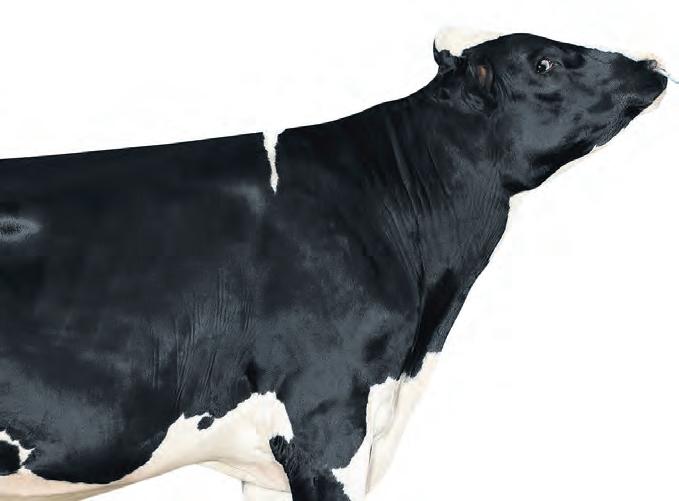







by swiping left making it easier to compare bulls.
Please note: Cows listed in the ABVs must be genomically tested.
To see DataGene’s latest release of Australian Breeding Values and indices such as the BPI, visit: https://www.datavat.com. au/abv-list-reports







































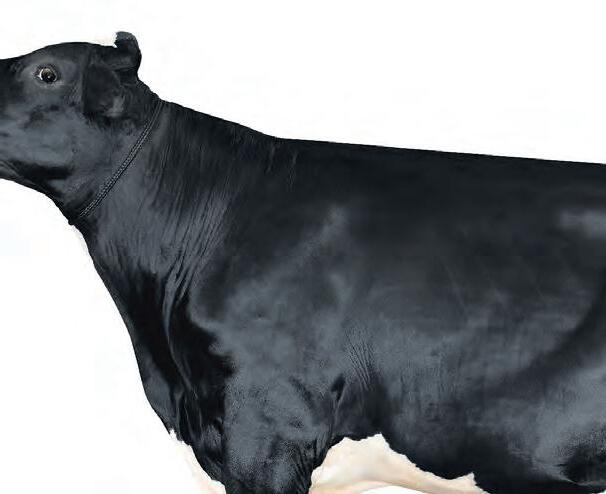
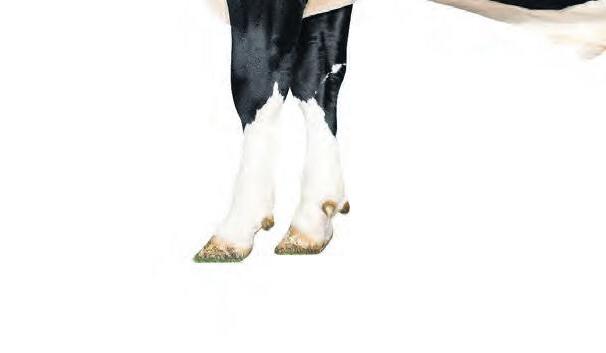



24 // DAIRY NEWS AUSTRALIA MAY 2024 AUSTRALIAN BREEDING VALUES OUT NOW! 2024 Dairy Sire Directory 50%50% PPP Leaders In Polled Genetics 75%25% p ESTATE PP ELLIS PP Photo: DENOVO 4798 ESTATE-PP-ET Photo: TTM ELLIS-PP-ET p BPI BPI 535 446 HWI HWI 509 486 DTR FERT DTR FERT 112 116 TEAT LENGTH TEAT LENGTH 104 100 1800 ABS BULL (1800 227 285) www.absglobal.com/au
Bill and Andrew Cochrane, from Craigielea Jerseys at Bamawm in northern Victoria, have bred the equal top Jersey cow, Craigielea Vicky 6151 VG 87, in DataGene’s April release of the ABVs. See page 25 for the full story.
Genetic gains off the charts
SOME AUSTRALIAN dairy farmers have made genetic gains of more than 200 per cent in recent years thanks to industry tools such as the genomic testing, the Balanced Performance Index, Good Bulls and sexed semen.
These huge genetic improvements, measured by increases in each herd’s average BPI since 2020, were uncovered as part of DataGene’s review of herd performance.
DataGene stakeholder relations specialist Peter Thurn said this analysis demonstrated that tweaks to breeding — using modern herd improvement tools — can deliver tangible benefits to a dairy farm business faster than ever before.
“Herd average BPI is generally something that moves very slowly, but in the case of some herds, their progress has been quite rapid,” he said.
“This fast improvement is due to the use of industry tools, especially genomics, and then using this genomic DNA information to choose the highest BPI animals to breed their herds’ next generation.”
Genomic testing analyses an animal’s DNA from a sample such as ear tissue or a tail hair, to predict future performance.
Heifers can be tested as young calves, so farmers can make early decisions about their future in their herd.
“The result of this can be improvements in fertility, production, survival, mastitis resistance and in some cases, this means less replacements are required from year-to-year
and it could open new income streams such as dairy-beef.”
Bamawm, Victoria Jersey breeder Bill Cochrane attributes the 168 BPI gain or 310 per cent rise in his herd’s average BPI to “losing the bottom of the herd” and genomic testing.
“We trusted genomics when it first came in and we were quite happy to use a bull just on his genomic figures,” he said.
“Genomics also played a role in eliminating the bottom end of our herd. For the past three or four years we’ve used beef on the bottom — according to genomics — and sexed semen to breed our heifers.
“Years ago, we’d just chuck a bull in with our heifers, but they are our better animals and using sexed semen ensures we breed our replacements from them.”
Bill and Kaye Cochrane operate Craigielea Jerseys with their son Andrew and will milk 550 cows this year.
In DataGene’s April release of Australian Breeding Values, the Cochranes have the equal top Jersey cow, Craigielea Vicky 6151 VG 87 at 502 BPI.
Bill said DataGene’s BPI system was a good guide for breeding because it enabled dairy farmers to chase production as well as type traits that improved the functionality of cows.
The BPI accounts for traits that affect a cow’s lifetime contribution to the farm business: production, health/fertility, longevity, workability, feed efficiency and type.
NSW Riverina dairy farmers Bernard and
Jenny James attribute their improvement of 359 per cent or 211 BPI units to a “tough” approach to managing fertility as well as sexed semen and using a group of three to four Good Bulls to improve herd traits.
Bulls that carry DataGene’s Good Bulls logo meet the minimum criteria for BPI and reliability and are available for purchase.
Bernard said genetic gains were valuable to his business and he was looking forward to future improvements.
“I’m excited to think about what’s going to happen in the coming years after this big jump in the last few years; it is really only just starting,” he said.
“We have a beautiful line of cows that are well-natured, and we don’t have to cull heifers that we used to. Milk production is slowly climbing, and we expect that to keep climbing.”
Using genomic data to make decisions about which heifers to retain — when they are young calves — and those to breed with sexed semen has helped Andrew Rushton and his family improve their BPI by 310 per cent to 172 BPI.
Andrew, his wife Jess, dad Bryan and mum Lee operate Benlock Jerseys at Rochester, milking 280 cows.
“The BPI takes into account so many other things that aren’t visual such as survival, daughter fertility and all the things you can’t see,” he said.
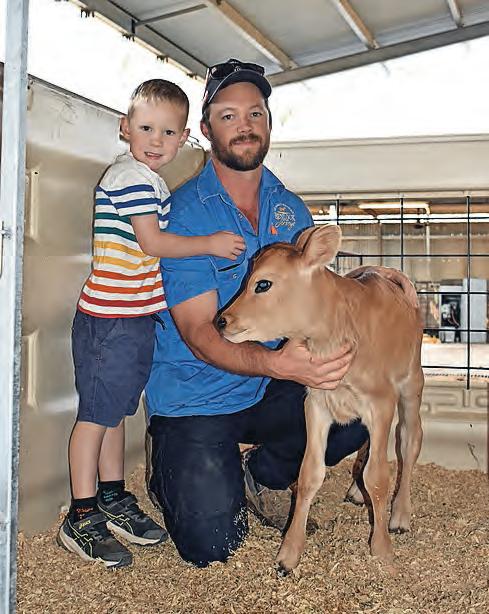
Andrew Rushton (pictured with son Brodie, 4), from Benlock Jerseys at Rochester in northern Victoria, has used genomics, sexed semen and the BPI to increase the genetic merit of his family’s dairy herd.
“We’ve improved our BPI by using genomics to understand our best BPI heifers before we start milking them and then we used that data to breed our best heifers with sexed semen to improve our genetic gain.”
Please note: Cows listed in the ABVs must be genomically tested.
ɋ To see DataGene’s latest release of Australian Breeding Values and indices such as the BPI, visit: https://www.datavat.com. au/abv-list-reports
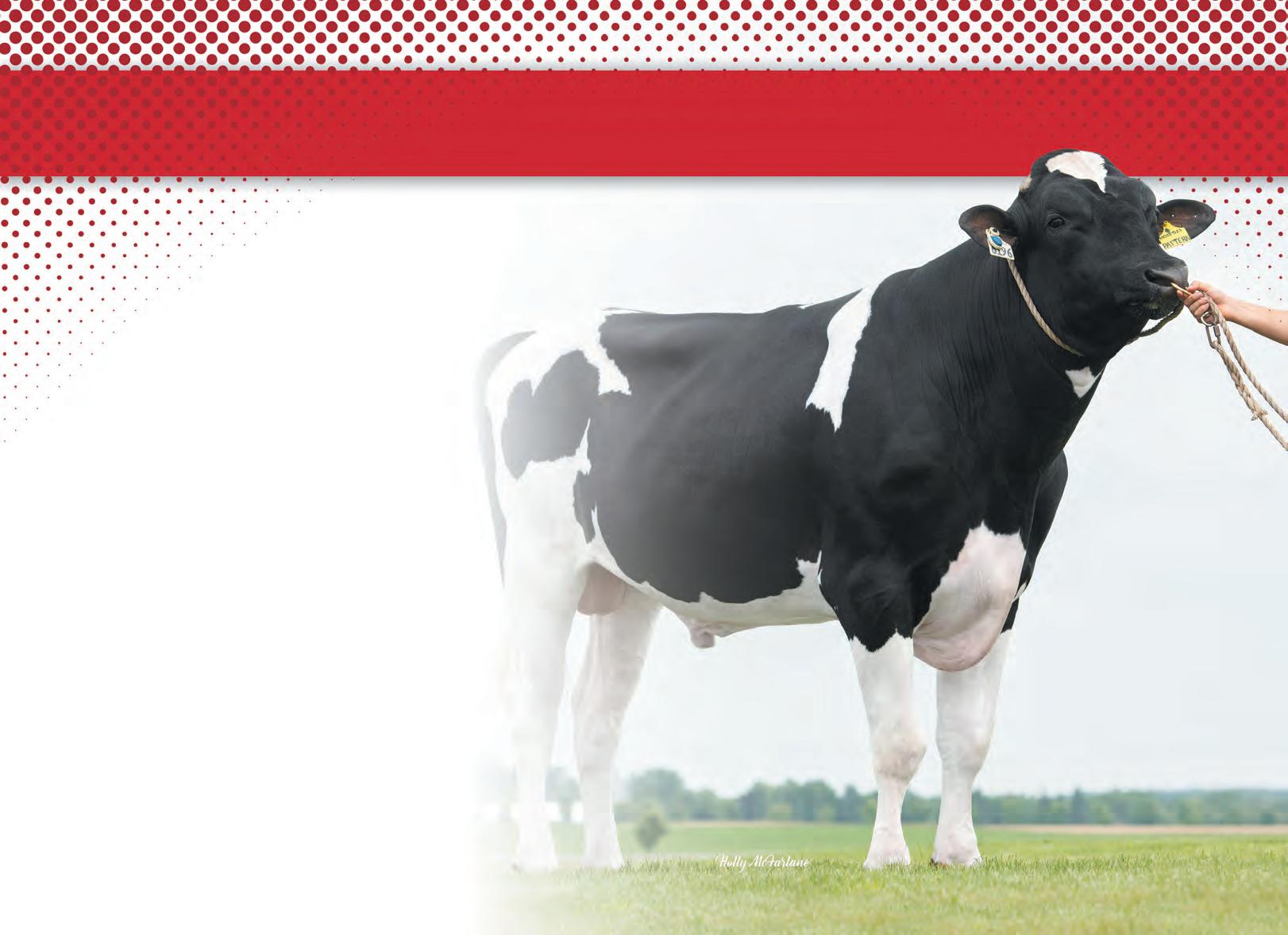
// 25 DAIRY NEWS AUSTRALIA MAY 2024 AUSTRALIAN BREEDING VALUES
THE TOP COWS AND HERDS
HOLSTEINS
Balanced Performance Index (BPI)
Carenda Jeronimo Vida is again the number one BPI Holstein cow. Vida is classified VG87 as a three-year-old and is a polled daughter of the high-ranking bull ABS Jeronimo (29HO18698). Vida has a BPI of 649 and was bred by the Kitchen family, Boyanup, WA. Vida is also the dam of the number one BPI Holstein bull AUSTRALIND.
Two cows from the same herd hold down second spot at 626 BPI and they are mother and daughter. Wilara Jeronima Jorda VG89 and her daughter
Wilara Nippon Jordonna are bred and owned by Trevor Henry and family of Tinamba, Victoria.
Not far behind this trio sits Adlejama Lastin Shauna 3699 GP83 owned by the Hogg family of Biggara, Victoria. She has a BPI of 624.
Top genomic heifer: With a BPI of 583, ‘16916’ bred by the Jelbart Family of Leongatha South, Victoria, is the top genomic heifer for the third consecutive ABV run. ‘16916’ has fantastic ratings for Daughter Fertility (121) and Mastitis Resistance (113) and is a daughter of the Genetics Australia bull KARAT.
Sustainability Index (SI)
A Carenda Pemberton daughter with an extreme protein ABV is the number one Sustainability Index Holstein cow. ‘16229’ owned by Jelbart Dairies of Leongatha South, Victoria has a SI of 1190.
The number 1 and equal number 2 BPI cows, Carenda Jeronimo Vida VG87 and Wilara Nippon Jordonna, are the 2nd and 3rd ranked SI cows.
JERSEYS
With a BPI of 502, the number one Jersey BPI cow from last run, Craigielea Vicky
6151 VG87 has been joined at the top of the list by Araluen Park Jiggy Sandra 86@ 2years. Vicky is owned and bred by Bill Cochrane and family of Bamawm and Sandra was bred by Trevor Saunders and Anthea Day of Shady Creek, Victoria. In second spot with a BPI of 492 is Beulah Gislev H Bouy 83 @2 years. She is bred and owned by Daryl and Lani Hoey, Wonthaggi, Victoria and is a daughter of the Viking bull VIKJGISLEV. Sustainability Index: Broadlin Ilagay 3791 EX-91 is the number one SI Jersey with an SI of 1055. Bred and owned by Linton and Lisa Broad, Wonthaggi, Victoria, Iligay 3791 is a daughter of the WWS bull Matt (7JE01344).
Genomic heifer: For an unprecedented fifth ABV run in a row, the top Jersey genomic heifer is Beulah Doug T2 Fairy bred by Daryl and Lani Hoey of Wonthaggi, Victoria. She has a BPI of 415 with solid ratings for most of the health traits. Doug T2 Fairy is also the top Sustainability Index and Health Weighted Index genomic heifer.
RED BREEDS






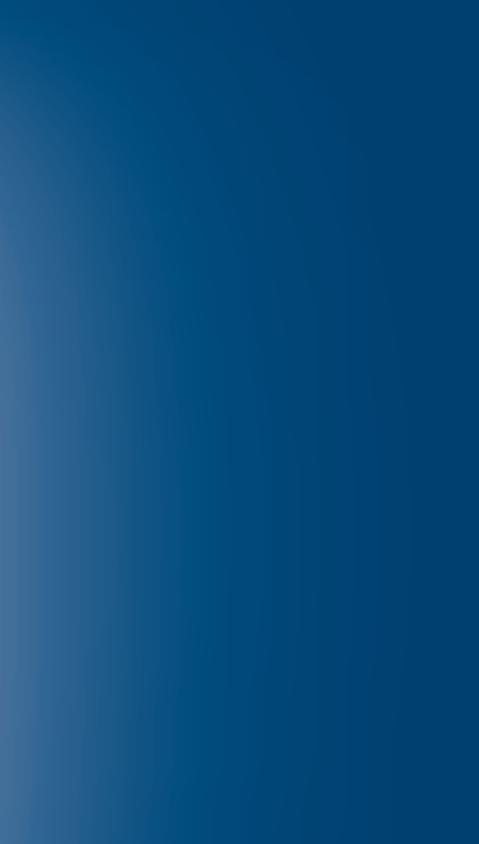


The best and most diverse team of bulls for Australian dairy farmers. April ABV results are unprecedented, PILBARA #1 BPI and SI daughter proven Holstein, AUSTRALIND #1 genomic Holstein, BORUNG #1 genomic Jersey, DOUGGAN #1 daughter proven Jersey, CNLYONS #1 Illawarra, ARBSKEETA, #4 Australian Red.



Blackwood Park 1416 with a BPI of 406 is the top Aussie Red cow. Owned by R & V Clarke, Mt Gambier and bred by Jan Raleigh of Timboon, Blackwood Park, 1416 is also the top Sustainability Index and HWI cow. She is sired by VR Faber (VIKRFABER).
TOP HERDS
Holsteins
The “Emu Banks” herd of Bryan and Jo Dickson has retained top spot with an average BPI of 358. It is also the highest herd for the Sustainability Index at 629 and number one for the Health Weighted Index (HWI) at 343.
In second position on BPI is George Wagner’s “Rengaw” herd with a BPI of 336.
Rohan and Graeme Sprunt’s “Kaarmona” herd, Karimba, Victoria holds down third position with a BPI of 322.
Jerseys
Con and Michelle Glennen’s “White Star” Jersey herd from Noorat, Victoria, is the top BPI, HWI and SI herd in the Jersey breed with a BPI of 258 and a HWI of 193 and a SI of 546.
Other breeds
Aussie Reds: Ron and Sam Graham of Numbaa, NSW, again have the number one Aussie Red herd for all the key indices.
Illawarras: The Williams family’s “Treeton” herd of Meningie is the top Illawarra herd for BPI (119) and HWI (118) while the top SI herd is Michael Tuhan’s “Riversleigh” herd of Murchison, Victoria with an average of 213.







Ayrshires: D & V Penfold, Willow Grove, Victoria, holds down top spot for BPI in the Ayrshire breed.
Brown Swiss: P & S Balfour of Kanoona, NSW have the top Brown Swiss herd for BPI, HWI and SI while the Cleggett family of Glencoe, South Australia are the leading Guernsey herd for BPI and SI. Please note: Cows listed in the ABVs must be genomically tested.

AND RED BREEDS CATALOGUES OUT NOW!




For more information about the Balanced Performance Index (BPI), Health Weighted Index (HWI) and Sustainability Index get the ABV Pocket Guide at: https://www. datagene.com.au/wp-content/ uploads/2023/10/ABVs-Pocket-Guide2022-WEB-Version.pdf
To see DataGene’s latest release of Australian Breeding Values and indices such as the BPI, visit: https://www. datavat.com.au/abv-list-reports
26 // DAIRY NEWS AUSTRALIA MAY 2024 AUSTRALIAN BREEDING VALUES
YOUR NUMBER 1 GENETIC SOURCE HOLSTEIN JERSEY
THE TOP BULLS
HOLSTEINS
Australian-proven sires
At 539 BPI, Carenda PILBARA is Australia’s top daughter proven Holstein sire. PILBARA comes from the acclaimed Carenda herd of the Kitchen family in WA. He is a high Protein transmitter with more than 200 daughters in his proof. Redmaw Fedora LASTIN moves into second position with a BPI of 523 based on 127 milking daughters in 20 herds. He was bred by Jared and Courtney Ireland of Lockington, Victoria.
With a BPI of 511, another Carenda bull, SONDALO comes in third on the daughter proven list. This Jeronimo son has solid ratings for most of the health traits.
Genomic bulls
Making it a double for the Carenda herd (top genomic bull and top daughter proven bull) is Carenda AUSTRALIND. At 581 BPI this Westcoast Rocknroll son is from the breed’s number one BPI cow, Carenda Jeronimo Vida VG87. This double marks an amazing achievement by Carenda Holsteins and the Kitchen family.
A new face on the list and a newcomer to the bull breeding game. Jelbart POLMAX bred by Tim Jelbart and family of Leongatha South, Victoria is a polled bull with a BPI of 565. The Jelbart family have bred many high BPI cows of late and this is their first bull to go into AI. With more than 2000 overseas daughters contributing to his ABV 7HO13981 –Sandy-Valley BD Freeborn slips from number two to number three BPI sire coming in just 1 point behind POLMAX at 564 BPI.
JERSEYS
Australian-proven sires
The number one Jersey ABV herd, White Star, owned by Con and Michelle Glennen, are also the breeders of the number one Australian Proven Jersey. DOUGGAN continues his reign at the top of the list with a BPI of 3864. DOUGGAN now has 827 milking daughters in Australia and rates well for health and fertility traits. DOUGGAN is also the top Australian Proven Sustainability Index bull with an ABV of 820. With a BPI of 328, CSCJAMIEO holds down second position. This newly proven sire was bred by Paul and Adam Lenehan of Crossley, Victoria.
PIXSTARP, the polled sire, is in third spot at 315 BPI. PIXSTARP has sons and grandsons in the top genomic Jersey list.
Genomic bulls
Brookbora BORUNG has some early milking daughters but not enough to move him o the genomic list. At 463 BPI, BORUNG is a clear leader.
CSCBRADY bred by the Sprunt family, Karimba, Victoria is the number two genomic Jersey with a BPI of 435. He has good ratings for ASI, survival and Type. CSCBRADY is also the number one SI Jersey with a Sustainability Index of 929. OULETTE (429 BPI) and PICKEM (417 BPI) are next on the list.
AUSSIE REDS
Three Norwegian Red sires fill the top positions in the Aussie Red list: 252NR12068 – Klopstad, 252NR12073 –Alme and 252NR11921 – Krovoll. These three bulls have daughters milking in Europe and this data has been combined with their Australian genomics to produce their final breeding values. 252NR12068 – Klopstad is also the number one Sustainability Index Aussie Red bull at 891.
ARBSKEETA – Johville Park Skeeta, bred by Greg and Kris Goulding, Cohuna, Victoria is the leading Australian bred sire with a BPI of 316 (4th on the list).
ARBSKEETA is an exceptional production sire with good ratings for Type and Workability. He is a son of Onstad P. VIKRVIMO is the top daughter proven sire with a BPI of 254 based on 126 daughters in 19 herds.
OTHER BREEDS
Ayrshire: The leading Ayrshire sire is
NZGSUPASONIC – Iwa Super Sonic with a BPI of 309.
Illawarras: The new genomic sire Cluain Lyons – CNLYONS is a clear leader at 336 BPI. This superior production transmitter was bred by Graeme and Michelle Hamilton, Mt Gambier, South Australia. Brown Swiss: GGIVIP is the top Brown Swiss sire at 243 BPI narrowly edging out 93SBJ03 Hercules at 242 BPI.
Guernsey: The top Guernsey bull is BLMAFIA, Brookleigh Rep Mafia at 215 BPI. In second spot is BLBULLET, Brookleigh
Bullet at 198 BPI. Both were bred by the Cleggett family of Glencoe, South Australia. For more information about the Balanced Performance Index (BPI), Health Weighted Index (HWI) and Sustainability Index get the ABV Pocket Guide at: https://www.datagene.com. au/wp-content/uploads/2023/10/ABVsPocket-Guide-2022-WEB-Version.pdf To see DataGene’s latest release of Australian Breeding Values and indices such as the BPI, visit: https://www.datavat.com.au/abv-list-reports

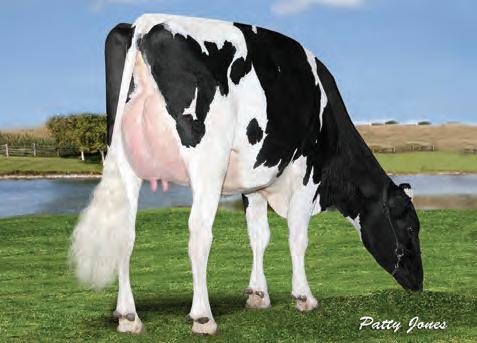













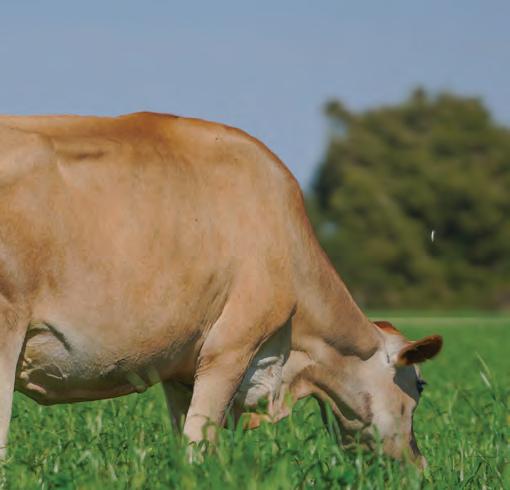



// 27 DAIRY NEWS AUSTRALIA MAY 2024 AUSTRALIAN BREEDING VALUES 4969 Princes Hwy, Camperdown Vic 3260 Phone: 03 55 932 016 tlg@tlg.com.au www.tlg.com.au Sales Manager: Darren Fletcher 0447 441 422 sales@tlg.com.au Oliver-P / Vanahlem EX93 / Larfalot EX90 Kings Ville BASHFUL-P •304 BPI 239 HWI 681 SI •107 Overall Type 110 Mammary System •953ltrs Milk 25kg Prot 14kg Fat •Impressive udders on the Australian daughters •Available now in Conventional & Sexed Semen Parfect / Magnitude / Muscadet Bundalong Parfect MAGNET Daughter: Brookbora Bashful Elfa - VG88pts MAX •New Release High TPI Australian Sire •2907 TPI 442 BPI •PTAT +1.26 UDC +1.25 •1224lbs Milk 56lbs Prot 89lbs Fat •Available soon in Conventional & Sexed Semen Two of the best from Gippsland Master Breeder Herds
#1 Australian standing proven Type & Mammary Jersey Sire
4th Dam: Seagull-Bay Ssire Debra VG88 @ 2yrs
Genetics in polled position
AUSTRALIAN DAIRY farmers will soon have access to the most genetically diverse and high-quality polled Holstein bulls ever.
This comes as more dairy farmers are buying polled bulls as a way to improve animal welfare and decrease farm workloads.
ABS Australia now has 24 homozygous polled sires — those that guarantee progeny without horns — in the Good Bulls Guide, including the highest BPI-ranked double-P polled sire ever, DENOVO 4798 ESTATE PP.

At number two is the new Holstein polled outcross sire BOMAZ POMPEII PP, 482 BPI, which has also been added to Australia’s offering, delivering high for vital traits such as Calving Ease, Daughter Fertility and Teat Length.
ABS Australia business operations manager Bruce Ronalds said there’s stronger demand for homozygous — double-P polled — bulls than ever before.
“By honing in on double-P bulls you can

move horned animals to polled in only three generations,” he said.
“That’s compared to using single-P, heterozygous bulls, where there’s still a 50-50 chance of breeding an animal with horns.”
New and diverse polled Holstein pedigrees have also made choosing polled genetics more attractive, while removing the need for disbudding horned calves is welcome on-farm.
“Make no mistake, ABS has concentrated on breeding high quality, diverse double-P bulls, to meet farmer demand,” Bruce said.
DREAMBIG is a2 and 109 for Daughter Fertility.
There’s also good news for farmers who invested in one of Australia’s most popular Holstein bulls and long-time breed leader ABS JERONIMO P.
Not only does the farmer-favourite Holstein remain at the forefront of the breed at number four on the ABV proven rankings at 493 BPI, but he continues to outperform his sons, even with 1021 milking daughters in his pedigree.




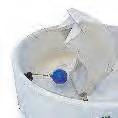


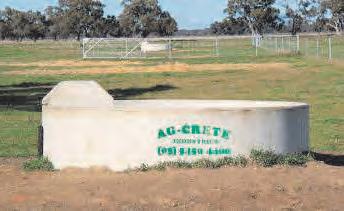
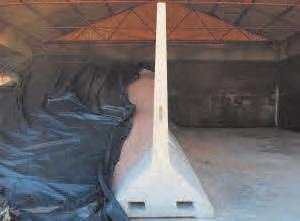





“This focus has involved strategic matings and even bringing horned bulls back into the polled pedigree to breed outcross double-P bulls.”












Australia’s number one proven udder bull KINGS-RANSOM S DREAMBIG is proving that high type and good production are possible from the same bull at 406 BPI.
An outcross for many Australian Holstein breeders, he’s known around the world for delivering high-producing cows with lots of fat and protein.
Two of the top six ABV proven Holstein sires have been bred from ABS JERONIMO P, but he continues to make an impact on Australian farms with his elite Cell Count, Mastitis Resistance, Survival and Workabilities.
Unique high milk and high component bull, DENOVO 15492 HUGO, ranked number five, has graduated to proven sire status at 491 BPI. One of the few bulls with 40kg of protein, he’s also 105 for Type and 106 for Udders.
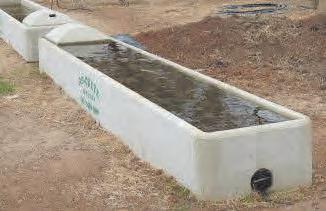





Northern Victorian dairy farmers Brent and Kim Mitchell, from Mitch Holsteins at Bamawm, have one milking DREAMBIG daughter and after using 100 doses, they have more to hit the dairy.
Red Holstein HOOGERHORST DG OH RUBELS RED has maintained his place as Australia’s number one proven Type Holstein after 12 months in this position. At 415 BPI, RUBELS is a farmer's favourite.
“Those that are milking them love them,” Bruce said.
“They are good balanced heifers with lots of width,” Brent said.



























“Even those that normally just have black and whites, don’t care that RUBELS is red, he’s so elite within the breed, they want to keep using him regardless of his colour.”
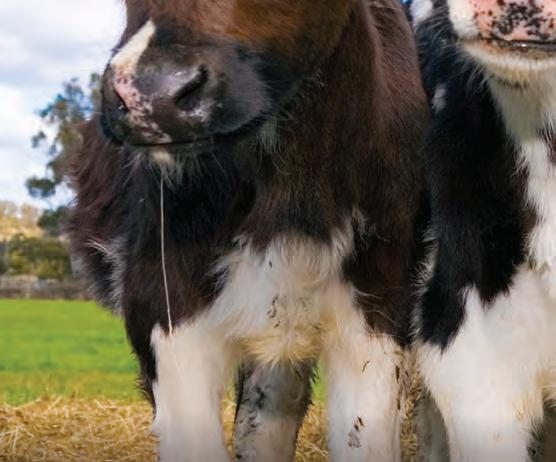





“This means they are not too tall, have good deep-rib and really nice wide rumps. He’s also easy to use because he has a bit of a different pedigree.”
Bruce said DREAMBIG, from the elite US stud Kings Ransom, was “wasted” pigeonholed within the show realm because of his great type.
PINE-TREE DURABLE-ET at number 15, 425 BPI, is further proof of the consistency of ABS’ bull line-up, with these long-time performers holding positions in Australia’s ABV proven rankings.

“Production wise, he’s really kicking goals and he gained ground, thanks to genomics, with his production,” he said.
“He’s not only a showy-type, he can certainly pay the bills.”
To read the full story, which includes ABS Australia’s ABV standings for Jersey and Red breeds, go to: https://www. dairynewsaustralia.com.au/news/geneticsin-polled-position/
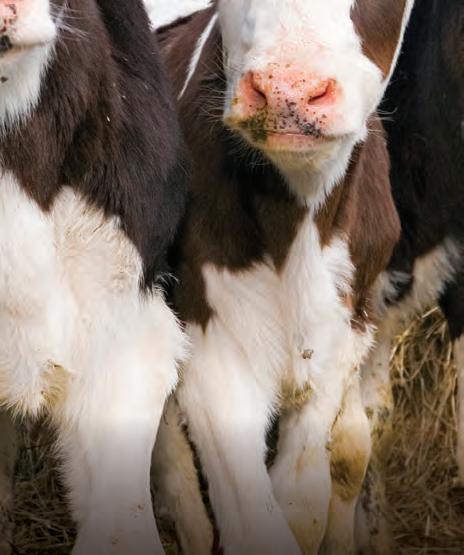
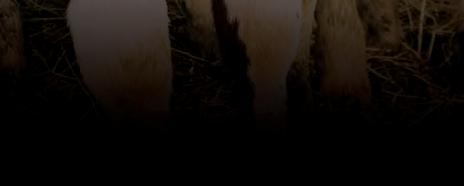
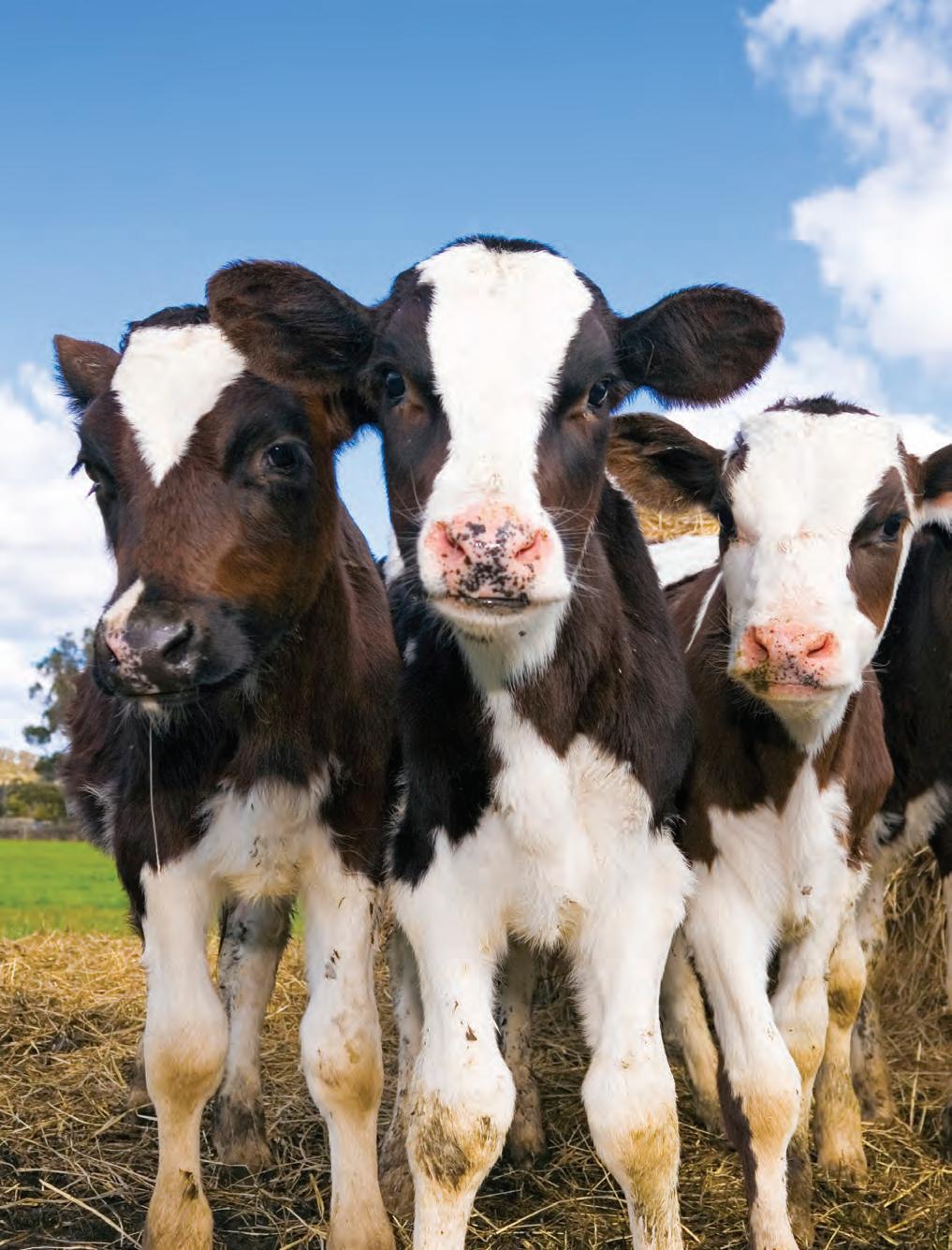
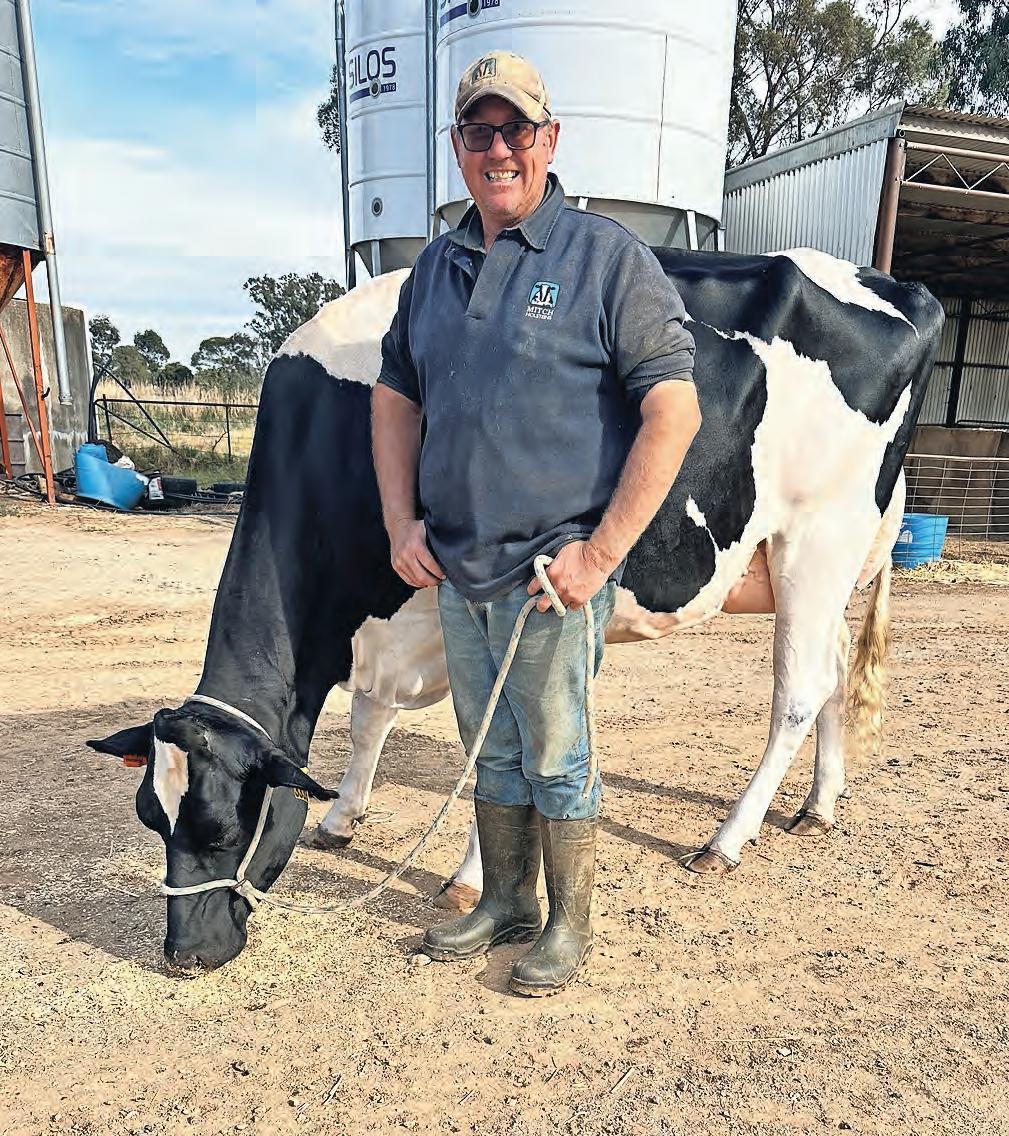
28 // DAIRY NEWS AUSTRALIA MAY 2024 AUSTRALIAN BREEDING VALUES AG-CRETE CRETE Call (03) 5450 4400 Visit www.agcrete.com.au ECONOMICAL BULK STORAGESOLUTIONS STORAGE SOLUTIONS & STOCK-PROOF TROUGHS Delivery VIC, NSW, SA ROUND TROUGHS FEED TROUGHS RECTANGLE TROUGHS GRAIN BUNKER WALLS DIVIDERS L-BLOCKS
Brent Mitchell, from Mitch Holsteins at Bamawm in northern Victoria, with DREAMBIG daughter MITCH DREAMBIG PALA GP-84.
Let’s talk about ear tags
BY COBY BOSCHMA
“OUT WITH the old, in with the new.”
It’s something Paul Quinlan of World Wide Sires Australia likes to say.
He’s been in the dairy business for decades and would recommend CowManager’s Fertility Module to any dairy farmer.
And not just because of the accuracy of its heat detection. Paul says it increases a dairy farm’s overall in-calf percentages.
“One of the biggest benefits of the system is it increases your six-week-in-calf-rate. It also picks up non-cycling cows, cystic cows,” Paul said.
“The system goes really well with the World Wide Sires genetic side of things.
“In this current climate of people looking at their breeding program and introducing sexed semen, you can utilise the technology to maximise the value of what you’re spending on genetics.”
CowManager is an international cow monitoring system, unique in its approach.
The system is a simple, small ear sensor which collects a wealth of data, 24/7.
The sensors measure ear temperature, activity, rumination, eating and resting behaviour.
The data is then made actionable and clear in specific alerts and graphs, all in real-time, allowing farmers and their staff to check on cows anytime and anywhere.

No more missed heats
Where farmers had to spend hours on heat detection before, with CowManager they’re spending 15 minutes a day, knowing exactly which cows are on heat, what heat state they’re in, and what’s the ideal insemination window.
“You use the technology to do all that work for you,” Paul said.
“You don’t have to use the traditional heat detection aids, whether it’s kamars or scratchies.”
This makes breeding a lot easier, saving valuable time and labour, too.
And Paul would know — he’s helped more than 120 Australian dairy businesses adopt the
THE FUTURE OF YOUR HERD
By Dr JEFF CAVE
In mid-March, Wodonga was host to the Australian Cattle Veterinarians Annual Conference.
This two-day annual event attracts more than 150 cattle veterinarians from across Australia.
The theme of this year’s conference was ‘The Next Level’, signifying the stateof-the-art material being presented.
Australia is fortunate to have well renowned cattle veterinarians who are pleased to share their knowledge.
A presentation by keynote speaker, Dr Sam Barringer from the United States, covered respiratory disease in calves and its diagnosis.
Like many of the conference presentations, Dr Barringer built upon the basics that respiratory disease in calves is caused by a combination of viruses and bacteria that work together in causing disease in calves.
Affected calves are likely to have predisposing factors such as inadequate colostrum intake and poor health, and environmental factors such as poor hygiene, overcrowding, poor air quality, and a lack of shelter.
Even if the calf recovers, an affected calf will generally have poor weight gain, an increased age at which it reaches maturity, an increased age at first calving, decreased milk production, and an increased chance of early culling.
The state-of-the-art technology presented was the use of ultrasound in diagnosing the calves which have respiratory disease.
Generally, calves that show the clinical signs of respiratory disease are severely

affected and if not treated early will always suffer a set back from their early illness. Interestingly, through ultrasound, a proportion of calves that appear clinically normal will also be found to have respiratory disease. It would be reasonable to ask, why don’t those calves appear to be sick? The likely reason goes right back to the fact that cattle were animals of prey. If they appeared sick, they were more likely to be hunted, therefore for survival they had an evolutionary advantage in appearing healthy for as long as possible. With the advances of technology that producers now have access to, they are in a stronger position to make better herdhealth decisions.
Dr Je Cave is senior veterinary o cer with Agriculture Victoria.
cow monitoring system in the past few years.
One of those farmers is Jason Burleigh.
The Victorian dairy farmer has used the system since 2015. Today, his herd consists of 300 cows, all tagged with CowManager ear sensors.
“We chose the system because of the simplicity of installing and replacing an ear tag, and for monitoring heat detection and health,” Jason said.
He said using the system for heat detection has improved their way of working.
“It’s enabled us to increase our in-calf rates by not missing any heats. Due to this, it has enabled us to tighten our seasonal calving pattern.
“The ability to detect a heat in cows that would not normally have had their scratchy scratched has been such a game changer for us. No more missed heats.”
Making AI more manageable
Trevor Shanahan from south-west Victoria claims the CowManager system has provided a more manageable workload on-farm. His 300cow tagged herd now cycles naturally.
“CowManager gives us more accurate timing of heats and we can AI accordingly,” Trevor said.
“It gives us greater certainty when using sexed semen and makes it more effective and economical.
“Joining is less stressful. It sorts itself out. There are no big AI days like there were when we used hormones.”
Trevor and his wife Sarah chose tags specifically for heat detection, accuracy and ease of use.
“The ear tag is easy to get on and off and it’s less intrusive than a collar,” Trevor said.
CowManager also integrates easily with Easy Dairy, Jantec and other drafting software. When cows are on heat, they are drafted out automatically for insemination.
There is no need to observe cows hours on end, hoping to spot the ones on heat. No more scratchies or remembering to do tail paint touch-ups. Monitoring fertility with CowManager covers it all.
Curious? Paul Quinlan’s always excited to talk about tags. Go to: https://www. cowmanager.com/australia/#getintouch – From CowManager
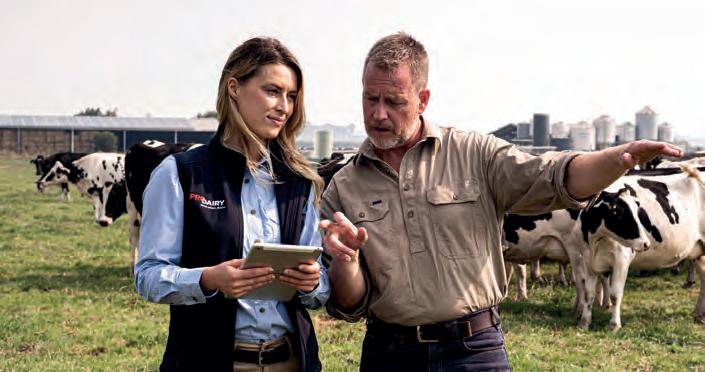

ProDairy can assist you with the development of a tailored
• On-farm visit by a ProDairy
• Review of the current biosecurity principles, the major risks and actions taken to reduce those risks.
• Development of a customised biosecurity plan.
Visit prodairy.com.au for more information.
 CowManager’s ear sensor is an accurate heat detector.
CowManager’s ear sensor is an accurate heat detector.
// 29 DAIRY NEWS AUSTRALIA MAY 2024 ANIMAL HEALTH PRODAIRY. WE’VE GOT YOU COVERED. Designed for Dairy Farmers. Delivered by Dairy Vets. PRODAIRY.COM.AU SCAN TO FIND OUT MORE. PROACTIVE BIOSECURITY PLANS TO MITIGATE THE RISK OF NEW DISEASES ENTERING YOUR HERD.
plan:
veterinarian.
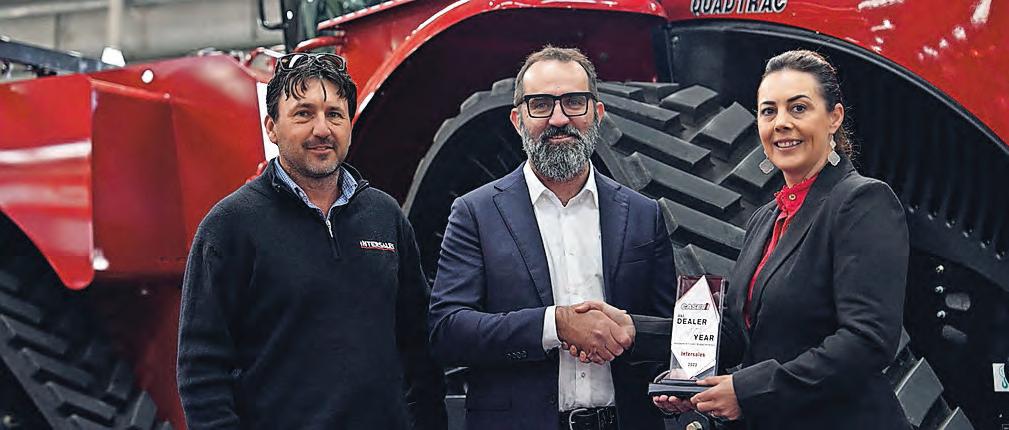


Case IH rewards excellence
CASE IH has announced the winners of its 2024 Dealer of the Year Awards, with Larwoods Ag and Intersales claiming the top honours. Intersales in NSW has claimed the award for Case IH Dealer of the Year (three branches or more). The company has branches in Temora, Griffith, Albury-Wodonga and Wagga Wagga.
Other finalists were O'Connors (NSW and Victoria) and Ramsey Brothers (South Australia).
The Dealer of the Year results are based on a range of criteria, including finance and business management, performance in sales and marketing, and parts and servicing, precision technology and total market share.
Intersales CEO Amanda Blachut said the award was a testament to the hard work of
their whole team.
“The dedication the team put towards training, team collaboration and knocking down barriers between departments is to be admired,” she said.
“We were up against some fierce competition so this win was unbelievably unexpected.”
Larwoods Ag Services, who are based in Kadina, South Australia, has been awarded Case IH Dealer of the Year (one to two branches).
They came out ahead of finalists Ronco Motors with branches in South Australia and Victoria, and Farmers Centre in Western Australia.
Larwoods Ag director Mathew East said it was a fantastic effort by the whole team, but particularly dealer principal Scott Mercer.
Mathew said the business had faced some challenges but with the help of CNH, they have been able to turn things around.
Receiving the award was a prime example of the team’s willingness to take on board feedback and evolve their business to better serve their customers.
The Parts and Service Dealer of the Year honour has gone to Kenway & Clark, with nine branches in NSW and Queensland.
Larwoods Ag Services and Agricentre South in New Zealand were the other finalists.
Cochranes of Canterbury in New Zealand has taken out the CNH Capital Dealer of the Year, from Farmers Centre and Larwoods Ag.
Aaron Bett, CNH business director
T TRUS T BLUE
With over 70 years of Farm Machinery experience behind every machine that carries their name, many Farmers trust the Strength, Performance and Reliability of owning a McIntosh machine.
The range of McIntosh Bale Feeders, Silage Wagons, Tip trailers and Farm Machinery are all designed to a strength and performance standard like no other.
Every detail has been carefully thought out to save you time, reduce breakdowns and provide years of trouble free operation.


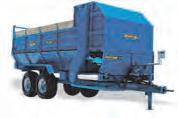
agriculture for ANZ, congratulated all the award winners, acknowledging the level of excellence achieved by the dealerships and the dedication to their customers.
“Intersales, Larwoods Ag Services, Kenway & Clark and Cochranes of Canterbury should all be very proud of what they have achieved in the past 12 months,” Aaron said.
“Their teams consistently go that extra mile, placing a high priority on delivering the service, support and advice their customers rely on.
“The standard across our network is very high, so to be successful in our Dealer of the Year Awards is an outstanding achievement, and recognition of the work that’s gone in across all aspects of the winners’ operations.”



 Intersales director Adam Blachut, CNH business director agriculture for ANZ Aaron Bett and Intersales CEO Amanda Blachut.
Larwoods Ag director Mathew East, CNH managing director for Australia and New Zealand Brandon Stannett and CNH business director agriculture for ANZ Aaron Bett.
Intersales director Adam Blachut, CNH business director agriculture for ANZ Aaron Bett and Intersales CEO Amanda Blachut.
Larwoods Ag director Mathew East, CNH managing director for Australia and New Zealand Brandon Stannett and CNH business director agriculture for ANZ Aaron Bett.
30 // DAIRY NEWS AUSTRALIA MAY 2024 MACHINERY & PRODUCTS To find your nearest dealer, please contact: www.tracmac.com.au 03 5625 1522
Kenway & Clark CEO Pete McCann with CNH head of parts and service for ANZ Heath Joiner.
An award-winning invention
BY JEANETTE SEVERS
TAKING 12 months to finesse his invention paid off for Allan Slater when he received the Best Technology and Innovation Award at Farm World this year.
The TracMac Raptor, an innovation to feed out hay and straw bales, was exhibited for the first time at any machinery show, during Farm World at Lardner Park.
The final prototype was completed in time for the March 22 to 24 field days.
The Raptor was invented by Allan Slater, of Trac Mac Farm Equipment in Gippsland, as a solution for a local dairy farmer.
“He wanted a trailer to feed large square bales in the paddock, and spread straw bales onto his calving pad and in his calf shed,” Allan said.
“My team researched what was in the market, and when we realised there wasn’t anything appropriate, we developed and built the TracMac Raptor.”
The Raptor is a hydraulic drive trailer designed to hold and simultaneously feed out two large square bales — each bale, eight by four by three foot.
The large square bales are placed on the machine on their side, making it easy to remove the baling twine.
Using a variable speed control valve, a unique twin ram push bar system pushes the bales into the rear-mounted horizontal rotor.
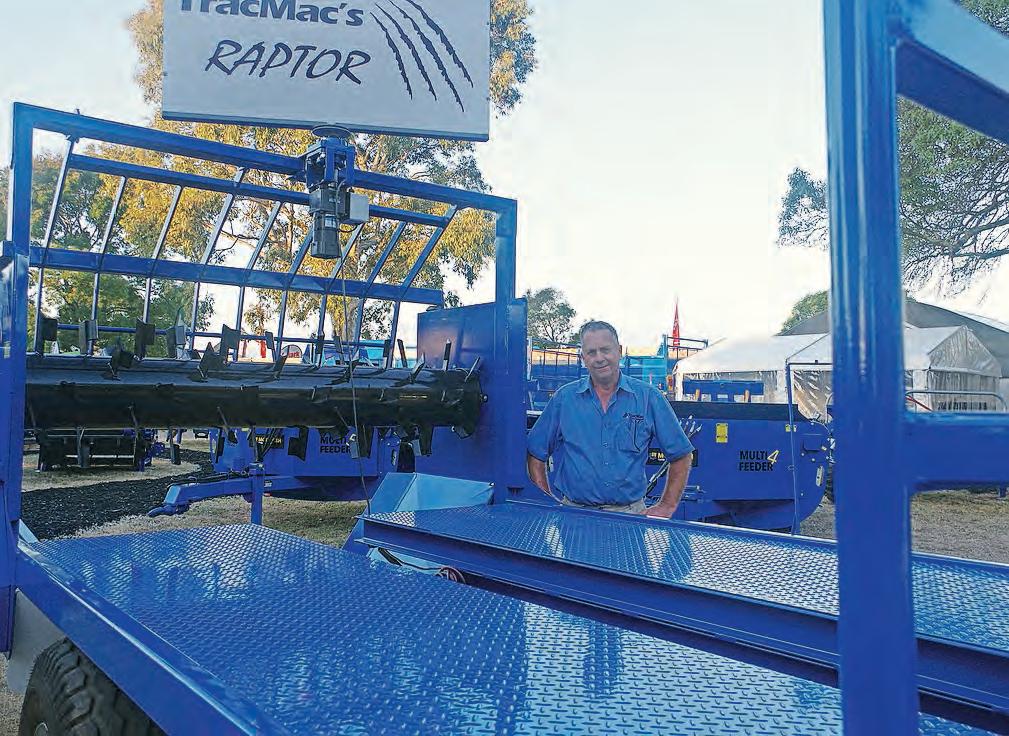

and straw. This creates a cost saving in machinery, as farmers look to straw as a viable alternate bedding material to sawdust and wood chips.
“The Raptor makes a very good straw applicator,” Allan said.
“By removing the windrow guards at the rear of the trailer, the unit will distribute a wide and even bed of straw, making it ideal for spreading straw on to calving pads or in calf sheds and herd sheds.”
Allan said the TracMac Raptor’s ability to perform both jobs with ease in a quick and efficient manner makes it a very versatile machine for many farming operations.
The rear-mounted horizontal rotor consistently and evenly breaks up the bales, distributing the hay or straw in a windrow feed pattern.
“The Raptor will break up the bale biscuit by biscuit,” Allan said.
“The windrow pattern of distribution reduces the damage done to pastures where large


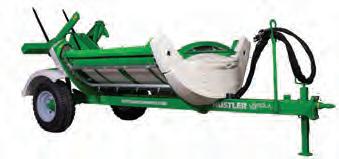
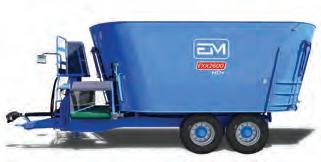
blocks of fodder are dropped on the ground, and reduces the amount of residue left after the livestock have eaten.
“Also, with its ability to feed the two bales together, this makes it a very quick and efficient way of feeding large square bales.”
The Raptor can be used for distributing hay


“The whole system only requires one set of remotes to operate, using around 45 litres/minute of oil flow,” he said.
“This makes the trailer suitable to use with smaller utility-sized tractors.”
The TracMac Raptor is available only through Trac Mac Farm Equipment, at Drouin.







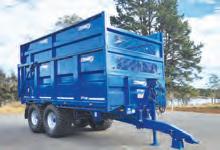
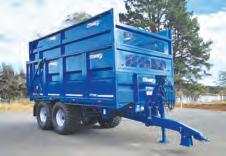




 Allan Slater with the TracMac Raptor, a newly invented trailer to distribute large square hay bales and bedding straw, on-site at Farm World.
The TracMac Raptor feeding out large bales.
Allan Slater with the TracMac Raptor, a newly invented trailer to distribute large square hay bales and bedding straw, on-site at Farm World.
The TracMac Raptor feeding out large bales.
// 31 DAIRY NEWS AUSTRALIA MAY 2024 MACHINERY & PRODUCTS
Photo: Allan Slater
















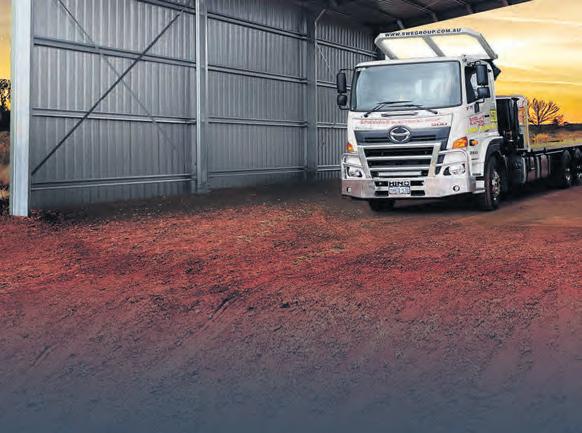
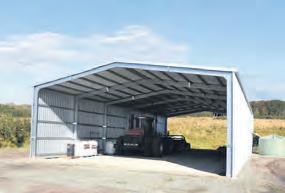

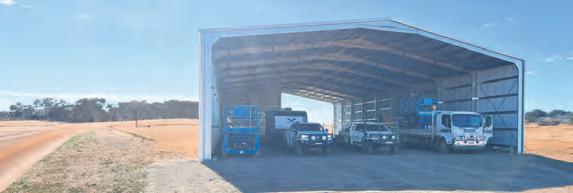




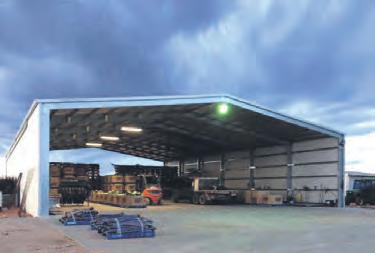






Images are from the Now Buildings range, for illustration purposes only. Imperial measurements are approximate. WA, NT & TAS slightly extra. Shed price only. Prices are based on collection, delivery extra. Extras pricing in bold is applicable at the shed purchase stage only. Extensions for existing sheds POA. Now Buildings will not be responsible to honour these prices once the total allocation has been sold. E&OE. Prices are Region A, Terrain cat. 2. Reg B slightly extra. *Now Buildings is not responsible for any changes made to tax legislation after the print deadline. Annual turnover limits may apply for the $20,000 instant tax write-off. You should consult your own tax advisors before entering any transaction. 100% Australian steel, 100% Australian made, 100% Australian family owned High tensile bolts & class 4 fasteners, gutters & downpipes included Site specific engineering, heavy duty connection & footing design High grade industrial strength materials and design THE NOW BUILDINGS ADVANTAGE MANUFACTURING HIGH GRADE SHEDS IN QLD, NSW, VIC, SA, WA & TAS REILLY 0459 259 920 JAMES 0413 104 820 JOHN 0437 699 111 CALL ON 1300 491 839 WEB: www.nowbuildings.com.au OUR BIGGEST SALE IS ON LIMITED NUMBERS & MASSIVE SAVINGS! DON’T MISS OUT ON THIS SALE! ABN HOLDERS ONLY 13M x 13.5M x 5.1M | $20,980 INC GST $20,000+GST INSTANT TAX WRITE-OFF SAVE TAX* 100% TAX WRITE-OFF ON HAY & FODDER SHEDS OF ANY PRICE MOST OF OUR SHED RANGE IS NOW AVAILABLE AT HEIGHTS UP TO 8 METRES! CALL FOR MORE INFO FINANCE NOW AVAILABLE ���� FOR APPROVED APPLICANTS 9M x 24M x 5M (30’ x 80’ x 16’8”) Four large 6M bays to suit all storage needs. Extend to 13M (43’) wide for an extra $8,760. 5.7M (19’) high version $31,990. EASY ACCESS $29,620 INC GST ONLY 9M x 13.5M x 4.5M (30’ x 45’ x 15’) Open front three bay shed in Zinc. Add an extra bay for $4,330. FARM SAVER $18,520 INC GST ONLY 9M x 16M x 5M (30’ x 53’ x 16’8”) Easy workspace with plenty of height for a hoist. Colorbond walls, doors and trim. TRADIES WORKSHED $34,560 INC GST ONLY 13M x 27M x 5.1M (43’ x 90’ x 17’) Awesome protection with drive-thru convenience. TRUCK STOP $38,120 INC GST ONLY 13M x 31.5M x 5.1M (43’ x 105’ x 17’) Open front with two large 9M openings for wide access, plus three more 4.5M openings. XL MULTI PURPOSE $49,010 INC GST ONLY 10M x 13.5M x 5.1M (33’ x 45’ x 17’) Open both 10M ends, perfect for hay, machinery or workshop. Add an extra bay for $5,160. HAY MATE $17,910 INC GST ONLY 12M x 16M x 4.5M (40’ x 53’ x 15’) Two spacious 8M open front bays. Perfect for rural storage. Building in Zincalume. RURAL DOUBLE $29,500 INC GST ONLY 9M x 13.5M x 4.5M (30’ x 45’ x 15’) Heavy duty building with a large industrial roller door and PA door. Building in Colorbond. COMPACT BUSINESS $24,760 INC GST ONLY 15M x 25M x 5M (50’ x 83’ x 16’8”) Industrial grade building. One bay fully lockable with a large industrial roller door plus PA door. STORAGE & SECURITY $53,960 INC GST ONLY 21M x 63M x 5.1M (68’ x 206’ x 17’) The ultimate arena for protection from the elements. Add lean-tos on each side as required. THE ARENA $129,410 INC GST ONLY 18M x 27M x 5.1M (60’ x 90’ x 17’) What a great shed! Industrial rated. Ideal packing or machinery shed. Add an extra bay for $7,450. 5.5M (18’) high version $51,830. AWESOME VALUE PLUS $50,120 INC GST ONLY 15M x 36M x 5.1M (50’ x 120’ x 17’) Room to put all the gear in. Add an extra bay for $6,470. LARGE & LONG $54,240 INC GST ONLY 15M x 22.5M x 4.2M (50’ x 75’ x 13’8”) Large fully enclosed shed, great for secure multipurpose storage. Includes four roller doors and one PA door. Building in Colorbond. SECURE STORAGE $55,690 INC GST ONLY 18M x 18M x 5.1M (60’ x 60’ x 17’) Great farm shed with easy access from both ends. Building in Zincalume. AUSSIE SHELTER $35,350 INC GST ONLY 15M x 36M x 5.1M (50’ x 120’ x 17’) Massive open front shed with four 9M bays. Ideal for a range of farm storage needs. Building in Zincalume. BIG OPENINGS PLUS $62,950 INC GST ONLY 18M x 40.5M x 5.7M (60’ x 135’ x 19’) Huge clear span openings for large machinery or easy storage. Add an extra bay for $8,040. 6.5M (21’3”) high version $82,800. HUGE OPEN ENDED PLUS Half end wall extra $77,080 INC GST ONLY
































































 animals the risk of infection is considered low to
animals the risk of infection is considered low to







 Lactalis will move its yoghurt and dessert processing from its Echuca factory (pictured) to an upgraded Bendigo site.
Lactalis will move its yoghurt and dessert processing from its Echuca factory (pictured) to an upgraded Bendigo site.



































































 Jake Connor addresses the GA 2024: Today, Tomorrow and Beyond conference.
Jake, Chelsea (holding her daughter Jade), Jodie (holding granddaughter Zoey) and Michael.
The cows are happier, healthier and producing more since the introduction of robotics.
Jake Connor addresses the GA 2024: Today, Tomorrow and Beyond conference.
Jake, Chelsea (holding her daughter Jade), Jodie (holding granddaughter Zoey) and Michael.
The cows are happier, healthier and producing more since the introduction of robotics.













































 BY JEANETTE SEVERS
BY JEANETTE SEVERS


 The Vening family — Jarrod, Lisa, Trent, Shawn and Peter — have invested in a new shed, supporting infrastructure and eight new Lely Astronaut A4 robots, on a greenfield site on their dairy farm at Hedley, in South Gippsland, Victoria.
Since the 1990s, Lisa and Peter Vening have overseen significant change on their dairy farm and have secured an ongoing future for their family.
The Vening family — Jarrod, Lisa, Trent, Shawn and Peter — have invested in a new shed, supporting infrastructure and eight new Lely Astronaut A4 robots, on a greenfield site on their dairy farm at Hedley, in South Gippsland, Victoria.
Since the 1990s, Lisa and Peter Vening have overseen significant change on their dairy farm and have secured an ongoing future for their family.











 The new shed began operation in May 2023 and has enabled herd growth to 560 cows.
A new feedpad is currently being constructed alongside the dairy shed.
The new shed began operation in May 2023 and has enabled herd growth to 560 cows.
A new feedpad is currently being constructed alongside the dairy shed.
























































 Dayboro dairy farmer Joe Bradley.
Dayboro dairy farmer Joe Bradley.





























 Warren Gallagher is a Norco farmer from Clunes in NSW.
Warren Gallagher is a Norco farmer from Clunes in NSW.
























































































































































































 CowManager’s ear sensor is an accurate heat detector.
CowManager’s ear sensor is an accurate heat detector.









 Intersales director Adam Blachut, CNH business director agriculture for ANZ Aaron Bett and Intersales CEO Amanda Blachut.
Larwoods Ag director Mathew East, CNH managing director for Australia and New Zealand Brandon Stannett and CNH business director agriculture for ANZ Aaron Bett.
Intersales director Adam Blachut, CNH business director agriculture for ANZ Aaron Bett and Intersales CEO Amanda Blachut.
Larwoods Ag director Mathew East, CNH managing director for Australia and New Zealand Brandon Stannett and CNH business director agriculture for ANZ Aaron Bett.


















 Allan Slater with the TracMac Raptor, a newly invented trailer to distribute large square hay bales and bedding straw, on-site at Farm World.
The TracMac Raptor feeding out large bales.
Allan Slater with the TracMac Raptor, a newly invented trailer to distribute large square hay bales and bedding straw, on-site at Farm World.
The TracMac Raptor feeding out large bales.





























